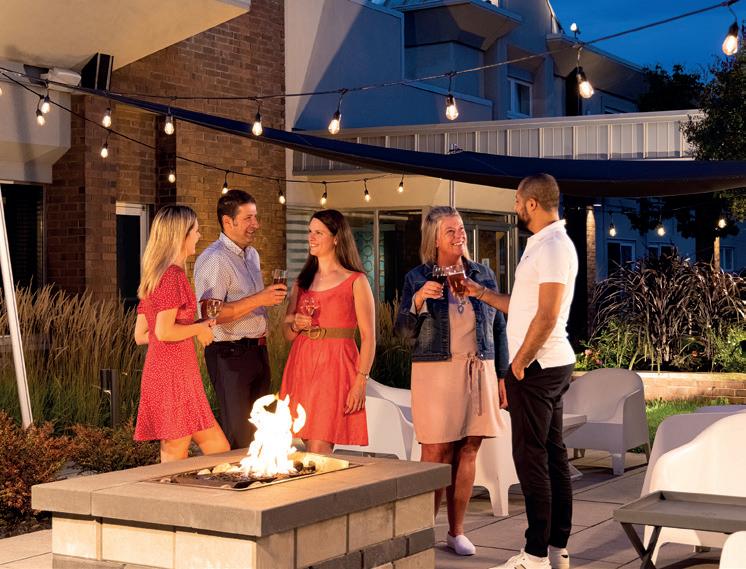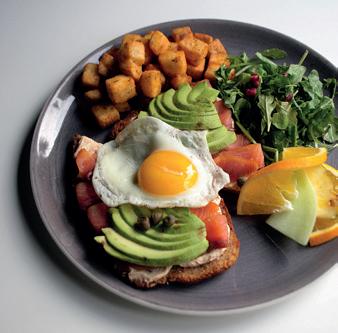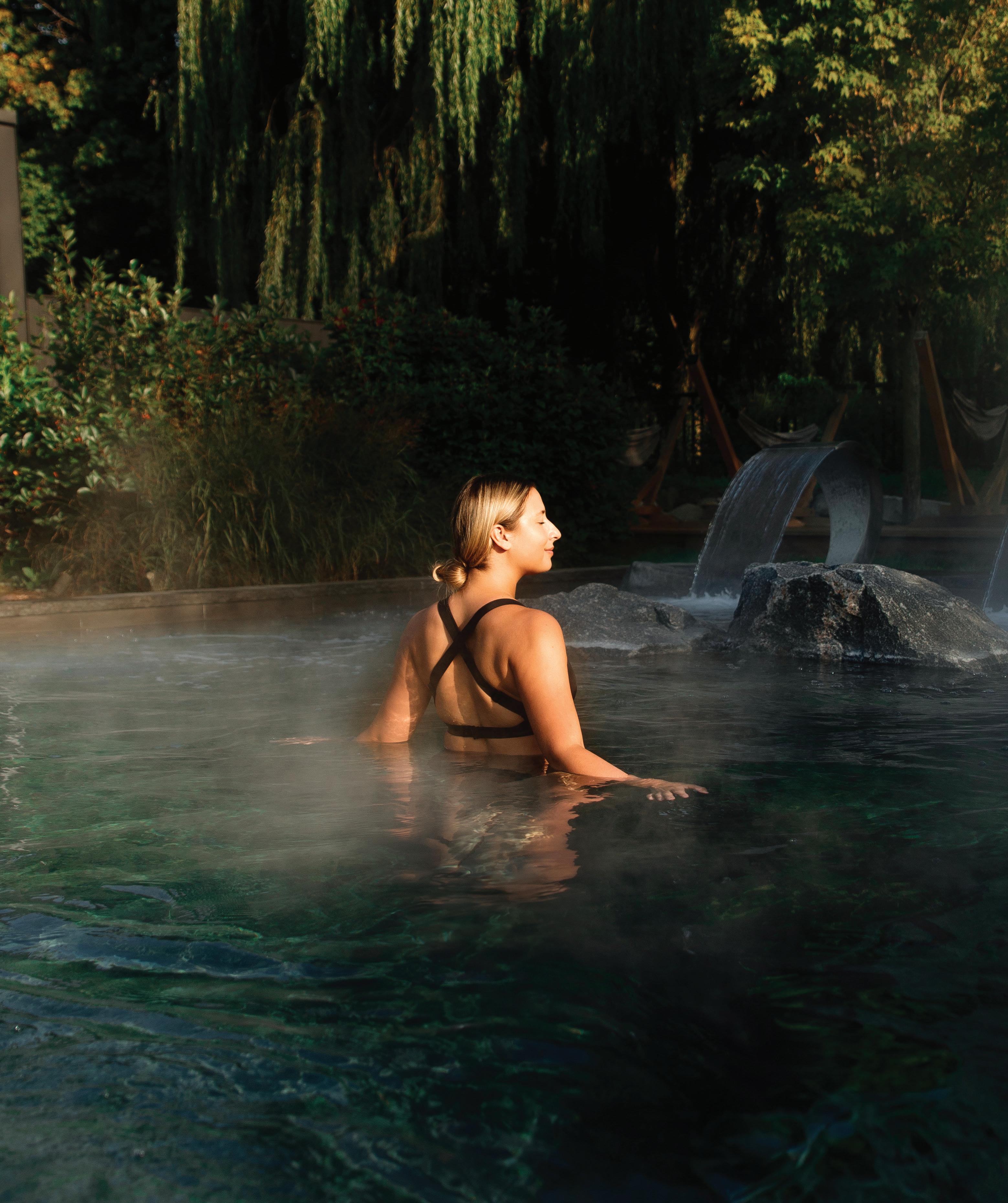


















ARCHITECTURE AND DESIGN
10 — 13
INSPIRATION
14 — 17
WORLD 22 — 25
SOCIETY
28 — 35
HOLISTIC HEALTH
42 — 55
WELL-BEING AT WORK
60 — 63
CULTURE
64 — 65
À TABLE 68 — 75
Guillaume Lemoine
President
Emilie Lefebvre-Morasse
Vice-President, Marketing and Sales, Editor in Chief
Arianne Filion
Assistant Editor in Chief
Caroline Croteau
Senior Director, Brand and Content
Sarah-Maude Dalcourt
Production and Brand Director
Rosalie Nadeau
Production and Brand Coordinator
Marie-Ève Trudel
Media Creativity and Brand Content Strategist
Designing an Eco-Friendly Home: Understanding and Planning, by Audrey Bernier-Perron
Feeling Fully to Better Move Forward: Interview with Phil Roy
Reinventing the Family Trip, by Franck Laboue
Reflections on the Body: Interview with Mikella Nicol and Manal Drissi Friendship: An Undervalued Lasting Love, by Karine Côté-Andreetti
Opening the Day, by Vanessa Bell
Standing on the Threshold of a New Beginning: A Story of Decluttering, by Ariane Martel Labrecque Cycle Syncing: Adapting Your Lifestyle to Your Menstrual Cycle, by Marie-Ève Trudel
The Work-Life Balance After Returning to Routine, by Dr. Lory Zephyr
Five Works to Celebrate Letting Go, by Nicolas Gendron
Glossary of Nordic Cuisine: The Forest as Pantry Recipe: Cabbage “Steak” with Miso Glaze, by Raphaël Podlasiewicz Letting Time Take Its Course, by Stéphanie Dupuy
Sarah Lamarche Artistic Director
Catherine Gaudet Linguistic Revisor
Gaëlle Meslin Linguistic Revisor
Bianca Des Jardins Photographer
SLRR Translation Firm
Translation
Printing Imprimerie Solisco Inc.
Advertising sales Christine Mailloux magazine@stromspa.com
To collaborate Arianne Filion on content afilion@stromspa.com
Publisher Strøm Nordic Spa 1001, boul. de la Forêt Nuns’ Island, Quebec H3E 1X9
Legal deposit — ISSN 2369-5897 National Library of Canada and Bibliothèque et Archives nationales du Québec. The opinions expressed in the articles of Strøm Magazine are the sole responsibility of the authors. The availabilities, vintages, and prices mentioned in the magazine are subject to change without notice. Any reproduction, in whole or in part, is prohibited without the permission of Strøm Nordic Spa. All rights reserved. Publication mail — 42293512
Strøm Magazine is printed in Quebec on Rolland Opaque30 paper containing 30% post-consumer fibre.
Cover page credits
Since the beginning, Strøm Magazine has had the immense privilege of collaborating with experts from all walks of life to write the articles that compose it. With great generosity, they offer us their knowledge and share their perspective—some from season to season, others more occasionally. It is with great pride that we invite you to discover them here.

KARINE CÔTÉ-ANDREETTI Karine is a journalist, teacher, and author. She explains several topics in a fun way on Instagram (@karineca). Her essay Ports d’attache: osons révolutionner nos amitiés ! is on sale everywhere.

VANESSA BELL A poet, curator, and literary activist, Vanessa Bell is the director of the poetry collection at Éditions du Quartz. She is the author of four books, including Fendre les eaux, an essay on Nordic swimming.

STÉPHANIE DUPUY Landing her first job at the SAQ really got her hooked! Several courses and 20 years in the wine industry later, Stéphanie loves drinking, sharing, and—above all—talking about wine! The sommelière has written for Strøm Magazine since 2018.

NICOLAS GENDRON A cultural journalist for Ciné-Bulles magazine, among other publications, Nicolas has written for Strøm Magazine since 2015. He is also—and above all—an actor, director, author, and artistic director.

AUDREY BERNIER-PERRON A professional interior designer at AUB&CO Design, Audrey creates nourishing, regenerative, and eco-friendly living spaces, placing her clients and the environment at the heart of all her projects.

FRANCK LABOUE A native of Brittany, Franck is eternally curious. A specialist advisor at Voyageurs du Monde, he ended up settling down in Quebec. He has written for the magazine for more than six years.

ARIANE MARTEL LABRECQUE The founder of Allo printemps, Ariane helps people declutter and get organized, conquer disorder, and regain control of their living spaces.
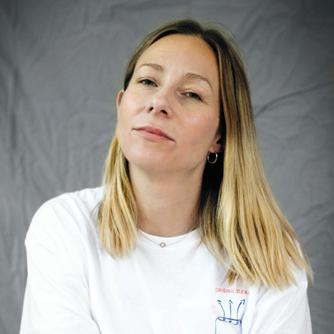
MARIE-ÈVE TRUDEL Marie-Ève is a mother and multidisciplinary strategist who is passionate about innovation and wellness. She combines professional development and mindfulness with a passion and expertise for creativity.

LORY ZEPHYR Lory is a psychologist specializing in parental mental health, attachment, and perinatality. She practices at a private clinic. She is also an author and the co-founder of the Ça va maman ? platform.
This new issue of the magazine explores the notions of change, renewal and transition. What do we need to leave behind? What do we need to preserve and strengthen, so that we can continue to move forward with peace of mind? And above all, how can we look to the future while taking into account what is essential for us today?
In the talks I give, I like to compare the company as a concept to a human being:
The head represents its intelligence, vision and know-how.
The body, its business processes and financial health.
The heart is its soul, corporate culture and mission.
Today, I’m offering a new metaphor: that of adolescence and the transition to adulthood. Strøm celebrated its 15 th anniversary last summer. Over the years we have grown significantly, both in terms of our operations and our team. We have had the privilege of welcoming millions of visitors, and every day we have contributed to their quest for balance and well-being. We’ve done everything we can to make sure they feel better when they leave than when they arrived.
The last four years have been particularly significant. Strøm has experienced the rollercoaster ride of adolescence: exponential growth, the challenges of the pandemic, and several other internal transformations.
Now, as we look to expand nationally and internationally, we need to ask ourselves the right questions: What business practices should we maintain? What old habits must we abandon? And in what ways do we need to reinvent ourselves to keep growing?
We are juggling these issues so that we can continue to develop in a healthy and sustainable way. Our ambitions are vast, but we remain faithful to our mission. Every day, we wake up with the desire to do good for as many people as possible.
This mission is the driving force for the whole team. It inhabits us, drives us and motivates us to make Strøm evolve into something greater than the company itself. Our greatest ambition is to make Strøm a “way of life,” as an antidote to the ills of the society in which we live today.
As with any growing human being, maturity brings its share of responsibilities. It is with serenity and enthusiasm that we face these changes, convinced that this transition will enable Strøm to do even more for your well-being and that of society, here and elsewhere.

Guillaume Lemoine President
Life is often marked by moments that force us to take a break and move in a new direction. Whether it’s the arrival of a child, time off for health reasons, a career reorientation, the loss of a loved one, or simply the desire for renewal, these events encourage us to question our inner compass in order to move forward better.
While some jump headlong into change without looking back, others move cautiously, their steps oscillating between melancholy and nostalgia. We then discover resilience, that ability to overcome turmoil with courage. A little scuffed up, we develop a new form of kindness toward ourselves.
Looking back, we realize it’s often these transitional moments that mark our lives the most. This is probably why we turn to our ancestors for advice. It’s like finding a future version of ourselves—one that has learned to leave behind what no longer serves, one that has known how to turn pain into wisdom and moves forward with unwavering grace.
In this new edition, we present to you stories of determination and testimonials filled with sincerity.
Through real and sincere conversations, we ask ourselves whether breaking free from social dictates might not be one of the secrets to embracing a more loving body image. Every body tells a story, and it’s in accepting and celebrating this diversity that we find true freedom.
Reconnecting with an ancestral practice, we explore why it’s important to focus on our bodies and their different states and list the ways in which cycle syncing can enrich our daily lives. By learning to listen to our bodies and honour our natural rhythms, we discover a source of inner wisdom that can transform our relationships with ourselves and others.
Then, reflecting on how our fear of emptiness and that of excess can coexist, we follow a path to decluttering that reveals the extent to which a messy home can become a mirror of our inner state, and the act of decluttering, a purification ritual.
Friendships in adulthood, work-life balance, travelling with children… Over the course of this 19 th issue, we offer you a selection of articles that provide practical advice, proven strategies, and inspiring perspectives to help you manoeuvre with agility through the phases of evolution: a humble guide to mastering the art of surfing the waves of change.
Happy reading and happy (r)evolution!
Emilie Lefebvre-Morasse and the editorial team
By Audrey Bernier-Perron, professional interior designer of eco-friendly commercial and residential buildings at AUB&CO Intérieurs
As environmental and economic challenges force us to rethink our way of life, building or renovating a home so that it is in harmony with nature and its inhabitants is a noble and essential ambition. Much more than a simple choice of sustainable materials or a passing trend, the eco-friendly home is seen as a living organism, evolving at the rhythm of its occupants, the seasons, and the years. It’s a reflection of our personality and a commitment to a sustainable future. By surrounding ourselves with experts in eco-friendly design and construction, we pave the way to sustainable and longterm thinking, integrating the principles of circular design and sustainability. Let’s explore the world of eco-friendly housing to discover how to create a respectful, scalable, and harmonious habitat, where the adaptation of the living spaces fuels optimal well-being, for the self as much as for the environment.
It all starts with thinking about creating a unique project, tailored to the land on which it is or will be established and to the needs of its inhabitants. It’s about designing an ecosystem built in harmony with its external and internal environment, in comprehensive and mutual coherence and respect. Thinking ecologically means thinking long term. How will your house adapt to the lifestyle changes of its occupants? How will it evolve over time while remaining timeless and functional? How will it remain useful and pleasant despite changes in fashion and the fluctuating needs of the families who will live there? It’s a matter of creating a legacy today for the future.
A sustainable home must be able to evolve with its users and remain functional and pleasant despite the passage of time. Buildings used to be designed to last centuries, but today, many require major renovations after just a few decades. Planning for longevity from the beginning helps minimize future costs and reduce the ecological footprint. A building’s sustainability doesn’t just depend on the materials used, but also on how it will be used over the years.
The renovation and construction sector consumes more than 40% of available natural resources. The growing awareness of the limits of natural resources and the impact on ecosystems is pushing us toward a new technological and cultural revolution. Today, with the technologies and knowledge available, it’s possible to construct buildings with a minimal impact on living beings and the environment.
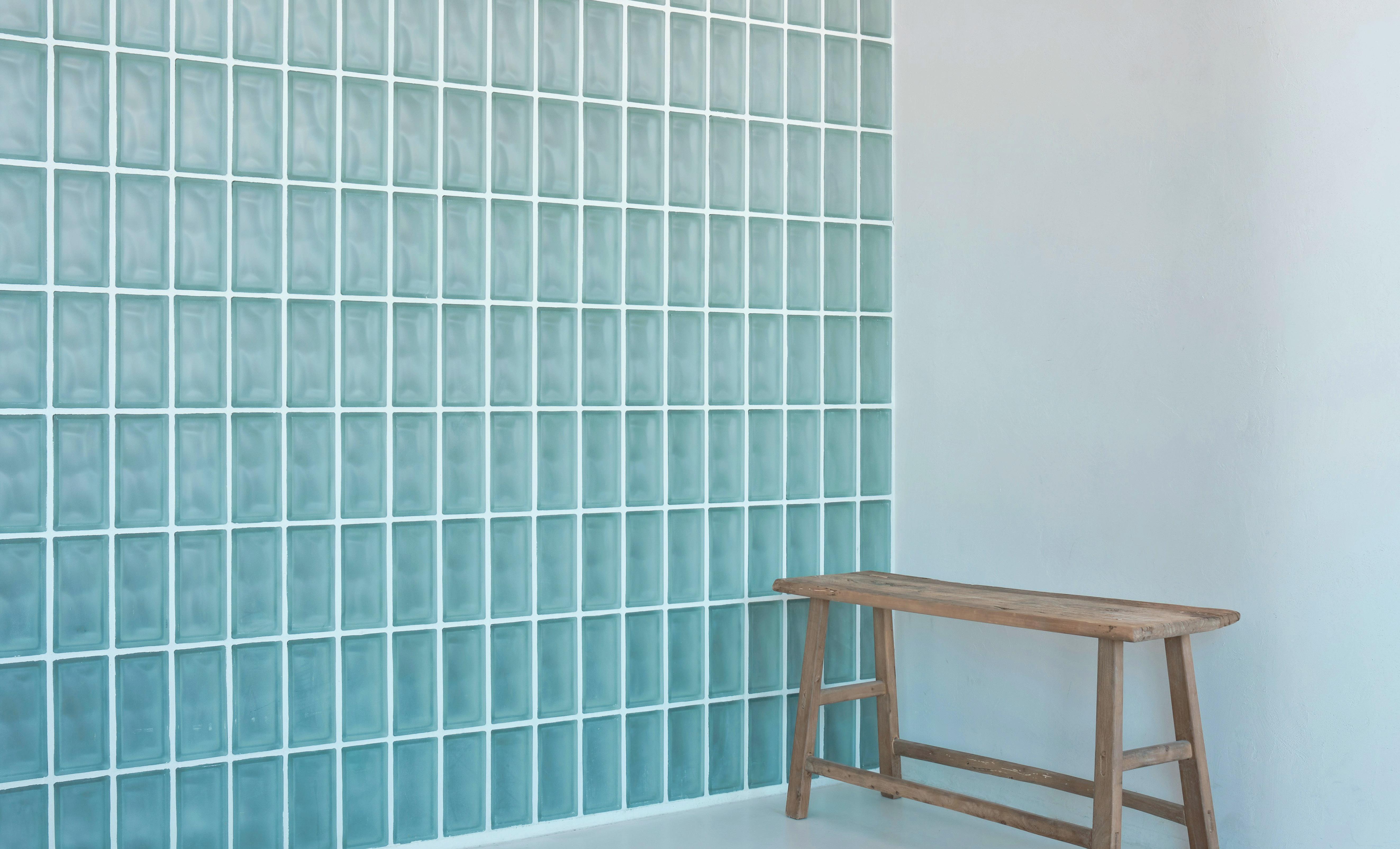
By reducing our ecological impact and using materials wisely, we can reduce resource extraction and waste production to create new products out of old ones. Circular design is based on the principle of the three Rs (reduce, reuse, recycle), as well as on deconsumption and degrowth. Instead of following a linear pattern from resource extraction to waste production, circular design uses bio-sourced, repurposed, or recycled materials. This eliminates the concept of waste and reduces our dependency on new resources.
The most efficient and ecological building is the one that already exists and is being renovated. Although building new ecofriendly homes is an excellent initiative, it’s even more beneficial to turn an inefficient building into an efficient building. That way, we improve the efficiency of an existing structure and remove an inefficient building from the market, thus constituting the most ecological strategy.

Circular design contributes to physical well-being by improving indoor air quality, promotes psychological well-being, and enables learning, creativity, sharing, and happiness. Good tips include selecting sturdy, repairable materials that can be refurbished or repurposed if a renovation is eventually required. It’s also a good idea to use materials produced and sourced locally without toxic agents or volatile organic compounds (VOCs). Ideally, these should be upgradable, recyclable, or even biodegradable. We can think of FSC-certified wood—that is, wood from well-managed forests—cherry plywood, and natural stone, as well as natural and artisanal products, among others. Choosing a company due to the values that it upholds is also a good practice.
Circular design is an accessible solution that reduces our ecological impact and strengthens our responsibility toward the environment. It inspires young people, families, and entrepreneurs to create positive changes while respecting fundamental, ethical, and cultural values, thereby enriching our daily lives.
Here are the criteria to evaluate to ensure eco-friendly development: site, shape, orientation, sun exposure, wind direction, vegetation placement, the geography of the land, aesthetics, light, colours, nature, the materials and their positioning, sounds, odours, textures, integrating art and memories, and communicating with yourself and the team throughout the planning and completion process. A well-designed and optimized space will not need to be redone in a few years.
Our houses are the only environment that we can consciously control. Ensuring that they are designed by taking our unique requirements into account is just another form of self-care.
By designing our buildings and homes in harmony with our unique personalities and the place where they are located, we create spaces that support our physical, mental, and environmental well-being. The objective of eco-responsible design is to promote healthy and regenerative choices to guarantee the sustainability of our well-being, our lives, and our living spaces.
Each individual is born with a unique combination of fundamental principles and values, natural elements, and different energy states that influence their constitution, personality, and response to environments. The key is taking the time to get to know ourselves, listen to our intuition, understand our needs and desires, accept ourselves as we are, and then carefully plan our living spaces, their renovations, or their construction. This allows us to make informed choices and live in a happier and more sustainable way.
Some people need grounding and warmth. They will feel comfortable surrounded by calming whites and earth tones, as well as warm metals such as brass and gold, and will want to avoid bright reds and overly stimulating patterns. In terms of finishes, they can incorporate breathable natural fabrics such as hemp and linen.
Others will need freshness and relaxation. A cooler colour palette such as blues, greens, and greys is ideal. Plants and silver accents should be privileged, while warm colours should be avoided so as not to exacerbate their intense nature.
Some people, known for their stability and calm, may benefit from a certain stimulation in their environment. It will therefore be important to design living spaces that promote activity, with plenty of natural light. Choosing warm, vibrant, and cheerful colours, as well as copper and gold accents, can provide a spark of energy.
In short, by embracing a sustainable vision of ecological design and choosing circular design, we can create living spaces with a minimal environmental impact that will improve our quality of life in the long term. By incorporating sustainable green building principles, personalized approaches, simplicity, and common sense, we take a step toward a happier, more balanced existence in harmony with nature. For ourselves, for society, and for the planet.




Hello, Phil. You wear many hats and are the father of two young daughters; hence, you have a busy schedule. How much importance do you place on relaxing?
“Quite a bit! I go for a massage almost every week, and as often as possible, because I’m a very anxious person. I feel a lot of my anxiety physically: it’s the cause of certain aches and pains, it affects the quality of my sleep, and therefore my energy levels the following day… Massage therapy helps me a lot in this respect.
I’ve also had a swimming pool since we moved to the suburbs, and I swim a lot, it makes me feel better. But I don’t just swim laps. I do handstands, I try to hold my breath, I do cannonballs, like a child! There are evenings when I swim alone for a long time and enjoy myself. It helps diffuse my stress.”
Has relaxation always been part of your life?
“It’s something I’ve learned to incorporate into my routine as I’ve gotten older. In the beginning, running was my escape. It freed my mind. And that led me to recognize that when I keep my body busy doing something, my head is better able to reflect and digest what’s going on in my life. For example, folding laundry is therapeutic for me. There was a time when I even took dishes out of my cupboards to wash them. I was washing dishes that were already clean! It relaxed me. When I don’t take the time to sit down and observe how I’m doing, my body speaks to me: ‘Hey my friend, I just want to remind you that you haven’t sorted this thing out, so here’s a pain point in your
Phil Roy is a comedian, host, actor and entrepreneur. Dynamic and generous both at work and at home, over the years he has learned to listen to his body and let his heart speak, hoping to pass on the best of himself to his daughters. Interview with the most thoughtful of emotional people.
left shoulder blade!’ It’s important to take the time to reflect, to have discussions with yourself, to identify what’s stressing you out, because otherwise things build up and turn into physical symptoms.”
What do you need to find balance in your dayto-day life?
“I’d say the separation of spaces. My office is at home, but outside the house, which means I have to take my bag and leave the house to go to work, and that separation makes all the difference. Separate places help me to define moments. I’m not one of those people who can open my laptop in the living room and be efficient.
Even when I lived in an apartment, I went to cafés… I even got a pass to a coworking space. I needed a place solely dedicated to work. In short, my balance lies in defining boundaries.
When it comes to work itself, I have a schedule and I stick to it. I don’t wait for inspiration to strike. I already write down ideas on a daily basis, but when I decide to switch on my computer and work, I give it my all.
And when we go for a bike ride with the girls, I don’t have a business call planned while I’m at the park with them. I devote myself fully to the moment I’m in, and that’s something I’ve learned to allow myself over time. I’m learning that it’s okay not to be available all the time. It’s okay if I call the person back in the evening or the next day. And if it’s really urgent, they’ll find a way to reach me, send me a text message. Anyway, I’m not an on-call surgeon either, I just make jokes, so we should be fine.”
You’ve often spoken publicly about the relationship you’ve had with your body since childhood. Having invested a great deal of time and effort in understanding and healing this relationship, how do you see your body today?
“It’s funny, because I’m still working on it in therapy, and I’ve just come out of a session…
It’s definitely getting better, but I can’t say I’m completely cured and always look at my body with kindness. There are times when I find it more difficult. I’ve often said ‘This is going to be the struggle of my life,’ but in the end, the further I progress, the more I believe that one day it will take up less space in my mind than it did before. I think it’s always going to be with me, but I don’t think it’s going to be a struggle forever.
I still want to have a body that doesn’t bother me, but today that just means having a body that doesn’t get in the way of what I want to achieve. I just want to be fit enough to move the way I want to.”
You weren’t always predestined for comedy. When you were younger, you turned to it as a social shield to divert attention from your looks. How has your relationship with comedy evolved over time?
“Comedy has always been my favourite means of communication. Today, I use it as a good icebreaker to talk about anything, but I’m also working to make it more than just that, my way of communicating, both personally and professionally. There are times when what I say isn’t funny!
I like to approach certain subjects with seriousness and authenticity, just as I like to approach others with humour. I’m not cerebral, I’m emotional. I have fun just by feeling things and communicating them.”
Does the relationship you had with your parents influence your fatherhood and your relationship with your own daughters?
“I don’t want my daughters to be afraid of me. Let’s just say that my parents were quite authoritarian, I often feared their reaction to certain things, and I don’t want my children to go through that.
But it’s also true to say that my parents inspire me in a thousand ways. I have two brothers, and my mother has always encouraged us and followed us in everything we wanted to do. I also got my love of reading and culture from her, and from my father too, who was quite a reader at one point. And today, I’m glad that Billie doesn’t ask me to watch TV on Saturday mornings, but to read books together.
So in short, I’ve taken the best of what I’ve been given, I’ve also gotten into certain habits, and I try to do the best I can most of the time.”
Does your parents’ relationship influence the way you live your relationship?
“Not only am I inspired by the couple that my parents were, but also the exes they are today.
When they were together, they shared passions, one of which was skiing, which they passed on to my brothers and me, so now I too want to share a passion with my daughters, whatever it may be.
“Separate places help me to define moments. I’m not one of those people who can open my laptop in the living room and be efficient.”
Then, when they separated, I know they were sad, but they were also able to recognize that they had had a magical adventure together, that of having a family, and that even if it ended, it could still be honoured. It’s important to let the water flow under the bridge, but let’s not break the bridge. That’s a lesson I learned from their relationship, and I apply it whenever projects come to an end. When a tour comes to an end, I refuse to never talk to the technicians in my life again, the ones I spent four nights a week with for years. We’ve been confidants, we’ve experienced something very intense together, and even if the closeness won’t be the same in the future, I want to pay tribute to the experience we’ve shared.
Now, even though they’re no longer together, my parents are still able to spend time with each other, and even enjoy doing so. It’s not unusual for both of them to come to our house for dinner, with their respective spouses.”
What do you find hardest to let go of?
“Of all the memories! I’m sort of a collector, I have a hard time letting things go.”
This winter, enjoy a unique ice fishing experience at the Port of Québec.
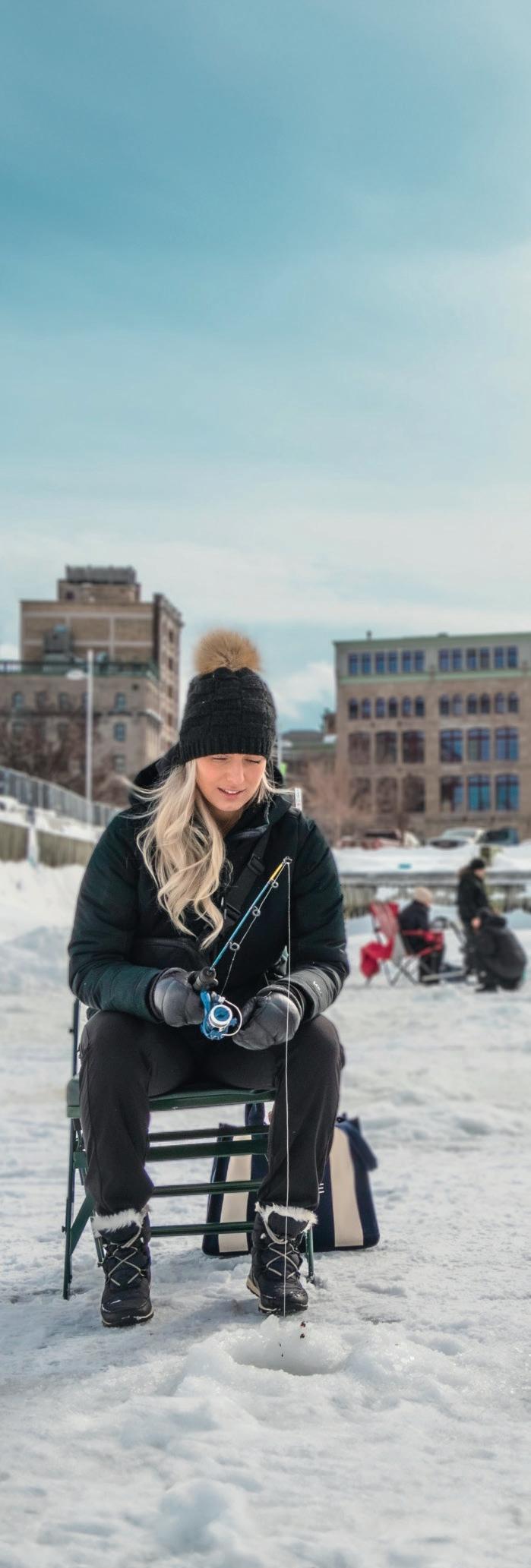



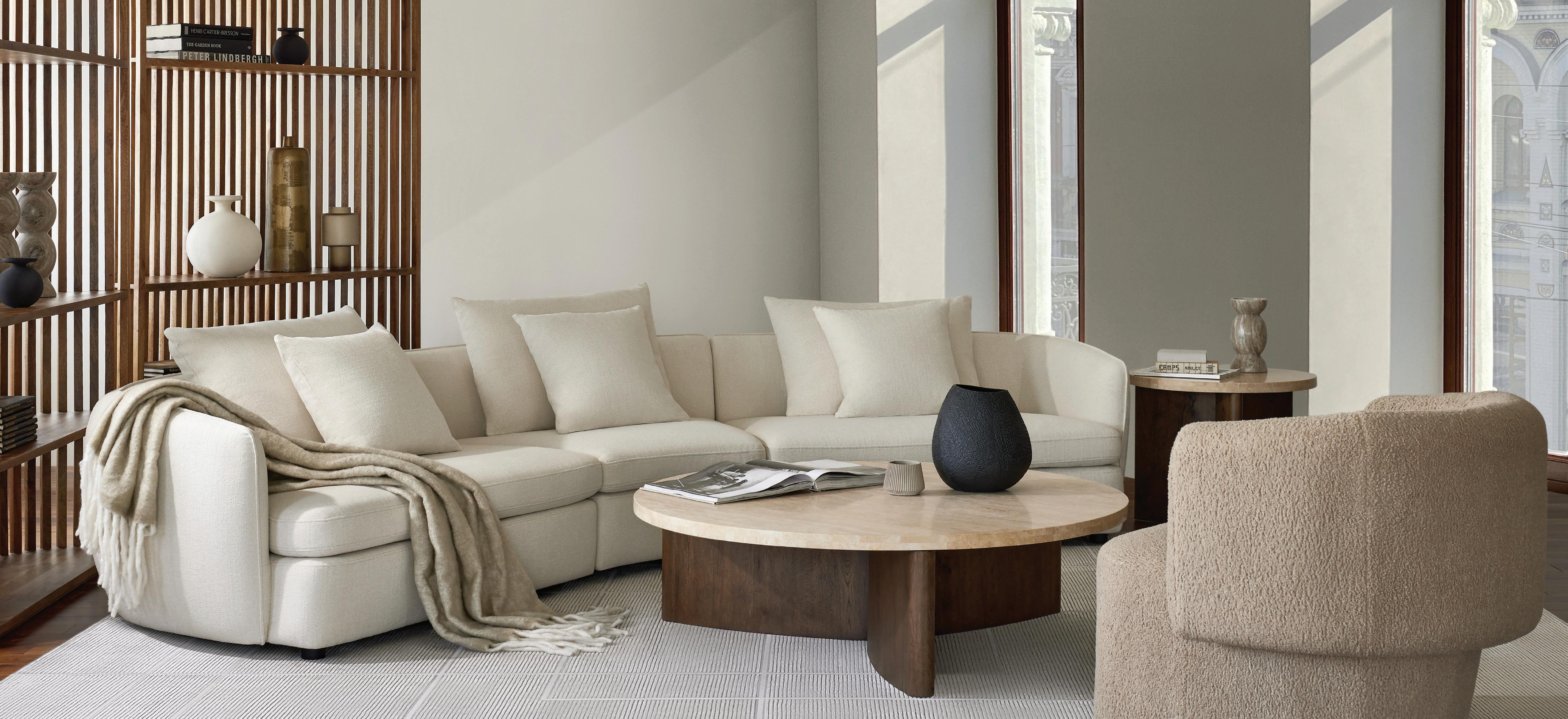

Relax and make yourself at home.
By Franck Laboue, Voyageurs du Monde

I wanted to replace Martine en avion . I had brought back from Paris a large, colourful book entitled Animaux du Japon . My way of waking her up to my world. In my little Jeanne’s library, by dropping off this new travel inspiration (at least, I hoped so), I had fallen back on the stories that fueled my childhood dreams. I had left my childhood fantasies there as a legacy, neatly lined up on her shelves. A bamboo geisha rubs shoulders with Treasure Island, Tintin in Tibet , an Air France 747 plushie, and The History of the World for Ages 7-9 . Sharing my irresistible passion, the words, images, and authors that made me tremble… an obsession, a quest to instill in her the same curiosity that still eats at me today. A legacy. I remember the desire, the expectation, when I was a child, of the next departure. Even more than the destination, it was the eagerness to be at the airport that consumed me for months. Already, relief only came once I was in the cabin of an airplane, ready to experience new memories with my family.
As the big departure for Brittany approached this summer, I decided to leave behind what was holding me back: control over my children’s vacation. I did the housework to move forward better and let go of the pressure of “not forgetting anything.” My new dream to make come true? Theirs. Letting the unalterable magic of travel take effect, without intrusion. Their spontaneity, their looks of wonder, their zany desires… children make us see the world differently with their sparkling eyes. Above all, beyond what awaits us when we get off the plane, the idea of finding myself with them in another world surpasses all other expectations. Yes, it’s quite possible that they will get bored, fall ill, argue with each other… is that really so serious? What does it matter, after all, if they don’t fully grasp the centuries of history that look down on them from the top of the bell towers of Finistère; they will inevitably remember something. I see them again with emotion, caught up in the calm of the churches, their feet treading the sacred ground. Their questioning looks were then absorbed by the riches of Breton devotion. Paul suddenly stopped making a sound and Jeanne had fun finding her name engraved under certain statues. A little further along, seeing them enter and run through the narrow stone tunnels of the Barnenez cairn was exhilarating. Stuck in my head like a song on repeat was their laughter echoing as they shouted toward the horizon, the wind blowing through their hair with a view of the sea. Being in the oldest human construction in Europe was far from interesting to them. One day while reading Asterix and Obelix , maybe this moment will come back to them. Those looks and laughs remain the most beautiful souvenirs, moments that won’t gather dust on a shelf or in our hearts as parents.
This quest for memorable moments, encounters, the unusual, and the “nice surprise” could only succeed with a certain letting go, we who are conditioned by so many things to control in our daily lives as parents. Letting yourself be carried away by spontaneity alongside your children—could this be the secret? I remember a drizzly day in New Brunswick visiting Fort Beauséjour, where I went back in time in my head. Meanwhile, two little blonde heads were simply having fun rolling around on the wet grass at the foot of the ramparts before starting to pick daisies for their mother.
Sharing, getting together elsewhere, disconnecting from everyday life, living differently… Family trips have so many positive qualities. And in particular, an unparalleled educational virtue to getting out of your world, meeting others, and having experiences together far from constraints and screens. On the return flight, Jeanne gives me a knowing look before whispering in my ear, “Dad, when are we going to Japan?”
Travelling with children is never an obstacle, as long as the organization is both well-anticipated and flexible. Our role is to free you from this essential task, before and throughout your journey. In our opinion, the success of this particular trip rests on two pillars: on one hand, logistics (routes, flights, accommodations, assistance), and on the other, personalized content according to age (activities, learning, encounters).
The schedule of the flights and connections, the number of stopovers, the time spent on the road each day… Each logistical detail will have an influence on their fatigue and patience, and therefore on your peace of mind. We always make sure to adapt your schedule to the age of the crew.
Depending on the destination and the tastes of each little traveller, we offer you a host of ideas to keep them busy during your stops. Activities tailored to their age, to be experienced by their side: nighttime outings to observe wildlife in Costa Rica, donkey rides in Sicily, surfing in the Philippines, scavenger hunts in Bangkok, baking classes in New York, graffiti lessons in Melbourne… A list as vast as their imaginations.
Finally, our French-speaking concierges at the destination are also attentive to the specific expectations of family travellers: finding a birthday cake or a car seat, seats for a show, a babysitter for the evening, a pediatrician… With just one call, they respond to your last-minute requests. In case of emergency, 24/7 assistance can take over. You can rest assured that you will always be in good hands.

Once upon a time in Denmark. Children might not know it yet, but Denmark is an eminently romantic country, a land of legends and adventures. Before leaving, we might read them some of Andersen’s stories: the story of the Little Mermaid, the national emblem, that of the little tin soldier, or that of the real Snow Queen. A way to prepare them for a journey to magical lands and for other stories, this time true, which have shaped the course of history with a capital “H”: the Viking people, not as boorish as you might think, who set up little fishing ports along the coast, which sometimes became large; stories of fishermen and herring galore… They will be fascinated by all this, and by the welcoming and generous landscapes of Denmark, where the borders between islands and continents are almost invisible. Something to create other memories together, to write other stories.
Their first steps in the Middle East in Oman. Going on a trip to Oman with your children means offering them a lesson on the vastness of the world and the importance of keeping an open mind— especially since few countries in the Middle East allow safe family road trips, and Oman is one of the rare exceptions. Omanis are known for their warm hospitality far beyond the borders of their country. From cities with white façades to desert expanses, from the majestic ochre cliffs of the mountains to refreshing oases, the little sultanate does things in a big way. The stops of this journey are specially designed for the youngest children. Every activity becomes a game, an adventure: from natural pools to encounters with turtles and dolphins in the gulf, not to mention desert dunes alongside dromedary camels… The beach at your hotel is most welcome when parents and children feel the need to regain their strength. Because in Oman, the adventurer’s life isn’t easy!









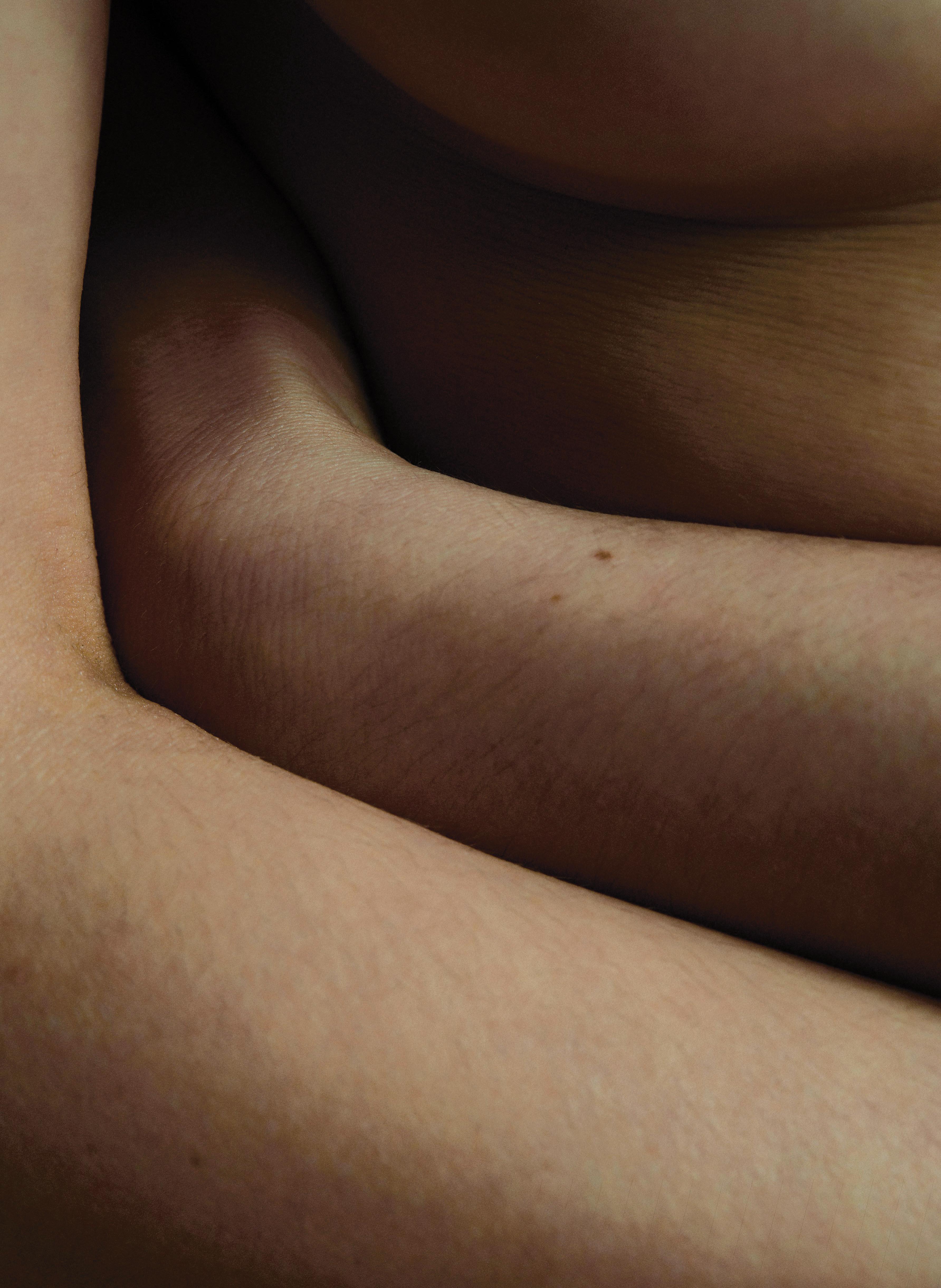
How old were you when someone first commented on your appearance? Have we really moved beyond the dictates of thinness and diet culture as a society? Are the ways you take care of yourself intuitive, or were they taught to you? Mikella Nicol, the author of Mise en forme , and Manal Drissi, a columnist and comedian, discuss the place of others in our relationships with our own bodies.
MIKELLA NICOL
MANAL
DRISSI
Hello, Mikella. In your latest novel, Mise en forme , you talk about how you started to become obsessed with weight loss when you were only 10 years old. That’s so young!
“Yes… and I don’t think I was an exception. I remember my grandmother telling me I had a big stomach, and I was often told that at school, too, by other kids. I don’t know if that still happens, but I remember adults commenting on my body a lot when I was a child.”
Hello, Manal. Did you have the same kind of experience when you were young?
“For as long as I can remember, people have always made comments about my body, even when I was three or four years old. But always in a kind and loving way. The women around me, who were role models for me, thought that by telling me to control my body, they were saving me from something. They told me ‘it’s better for you to know this now so you can do something about it than to do nothing and regret it later when you’re left out because of it.’ There was a form of fatphobia in there that was so internalized that it was exploited thinking that it was doing good.
“This is why these ideas are hard to deconstruct afterwards, because the relationship of girls and women with their bodies doesn’t always come from a place of hatred of others.”
M.D.
To listen to the full interview hosted by Evelyne Charuest, follow our podcast Centré sur l’équilibre.
M.N.
So, we should avoid commenting on children’s bodies once and for all...
“Yes, and not only that; we should avoid talking about our own bodies in front of children. Most children have never directly been told ‘your body isn’t right,’ but they’ve seen people they love making comments about theirs. As a mother, I realized that the way I talked about my body had a huge influence on how my child would perceive his own body, and the bodies of others, for the rest of his life.”
There’s a question of belonging in all this. Even the word fitness contains the word fit, meaning to be part of, to be capable. But what exactly are we capable of?
“That’s the question I ask myself in my book! The words used in the field of personal growth really interest me. We’re promised that by working on ourselves, we can become ‘better mothers,’ ‘better friends,’ ‘better girlfriends,’ and it’s always in relation to others; the goal is never to be a better person for oneself.
“It’s interesting, this idea of belonging better, because for me, I’ve always seen femininity as something into which I wasn’t capable of entering. If I could follow role models, literally watch them and imitate them, maybe I would be ‘capable’ of being part of femininity myself.”
M.D.
“Everything sport could offer me […] was cancelled by the fact that the numbers on a scale weren’t going down enough and, in the eyes of others, I wasn’t gaining in value.”
Where do you find your role models?
“I absorb them! It’s hard to say; it’s culture, it’s everywhere. And yet, we’re always asked as women to detach ourselves from our culture. We’re told, ‘yeah, but you know, you have to take some and leave some.’ Well, taking some and leaving some is a cognitive process, and it’s a full-time job. I don’t have time to take some and leave some, when everything I see every day wants to impose a way of being on me. I have to sort through the messages one by one? It’s extremely difficult to do that, because we don’t even realize what information we’re taking in.”
Manal, how do you see fitness?
“I’ve never considered myself an athletic person, but I played soccer and basketball, tried climbing, signed up for different gyms… But I’ve never actually been thin. And for me, thinness and the term ‘athletic’ are so intertwined that I’ve always felt like an impostor just using the word ‘athletic.’ It didn’t belong to me, and it was like lying to say, ‘I’m athletic.’ It was as if, by looking at me, you would have proof that I wasn’t. And that means no matter how much I might enjoy physical exercise on its own terms, it would always become a tool of control, something I had to use to change myself, and it wasn’t worth doing if the results weren’t there.
“So, everything sport could offer me—that is, being less anxious, having better physical health, sleeping better, doing better at school—all that was cancelled by the fact that the numbers on a scale weren’t going down enough and, in the eyes of others, I wasn’t gaining in value. That tainted my relationship with sport so deeply that I’m still paying for it even now.”
M.N.
What is your vision of self-care?
“My position on this subject has evolved in recent years. In the beginning, I understood the appeal. I said to myself, ‘we live in a stressful society, so it’s good to take care of ourselves and listen to our needs,’ only to realize that self-care is just another thing that has become an industry. It’s one more thing we have to spend money on individually, one more thing that allows companies to tell their employees ‘do yoga on your lunch break’ instead of implementing shorter work weeks and offering benefits that actually allow people to have a better quality of life. For me, the self-care industry is the same industry that told us 20 years ago, ‘if you don’t lose weight, you’re worthless,’ and which tells us today, ‘if you spend 50 bucks more, you’ll feel better.’
“In my opinion, self-care reached its limit very quickly, and the outcome of this stressful life we lead is community care. It can’t be self-care, which takes us back too much to individualism, which is one of the sources of the problem.”
“All my life, I’ve been told that I don’t fit in, and for the past 10 years, maybe even less, we’ve been told overnight that we have to accept ourselves as we are. And I was unable—like many people, I think—to make that transition so quickly. And there, I hear: ‘Well, it’s because you have to accept yourself. What do you mean you don’t accept yourself?’ Today, if we speak negatively about ourselves, it’s as if we’re projecting our negative self-talk onto others.
“It’s the same thing for self-care: I have no intuition for self-care. I don’t really know how to take care of myself, without it being rooted in productivity or serving some other goal like being in shape, for example. And strangely, the nights where I feel like I’m doing the most self-care are the ones where I spend four hours in front of the TV.”
M.N. Why?
“Because I’m not performing! Sitting down to do yoga with my little diffuser, I was taught that. It comes from an external source. Someone told me that was self-care, but that’s not always what I need. Taking my Epsom salt bath, sometimes… it doesn’t work.”
How do we find our freedom through all the messages we receive?
M.N.
M.D.
“Getting older isn’t so bad (laughter). I recommend it! All my life, women have told me, ‘you’ll see; things will calm down.’ And it’s true that things eventually settle down.
“I think getting in touch with reality, seeing more real women’s bodies, can do good, too. For example, in clothing exchanges between women, there’s always a stage where everyone strips down to their underwear to try on the clothes, and every time, it makes me realize how rarely I’ve experienced this. Being with lots of women in their thirties, all different sizes, not self-conscious, in their underwear… I really wondered why we didn’t get undressed more among ourselves (laughter). In a very healthy and commonplace way, just with the aim of exposing our gaze to more bodies. In addition, when they’re our friends, we’re already biased toward kindness, and it’s even easier to see the beauty of bodies.”
“I think neutrality is something revolutionary, and for me, it’s the logical continuation of the body positivity and diversity movements.”
What is that?
M.D.
“Neutrality invites you to consider your body like your vehicle. It’s what contains who you are, your soul, and that’s all. It doesn’t need to be beautiful or ugly, to perform or not, it doesn’t need to have value in the eyes of others; it exists, period. We have to stop looking at the body as something at the market, as something to comment on. I realize that in my life, I’ve witnessed far more conversations between women where we’re critical of ourselves than conversations where we’re neutral about our own bodies. It’s so common to get together with the gang and say, ‘Ah! I have to lose ten pounds,’ ‘Ah! My hips…’, ‘Ah! My cellulite….’ We don’t inhabit our bodies; we’re outside and looking at ourselves: ‘Am I sitting up straight enough? Is my stomach sucked in enough?’ We’re always in a play, and it’s so liberating to finally feel at home in our bodies. To move like we want, to sit like we want, to really exist, and to embrace our personalities.”

By Karine Côté-Andreetti, journalist, teacher, and author
In 2018, a study highlighted the secret of long, happy lives. None of the researchers from Harvard University who contributed to this ambitious research project, which followed 774 men and their children for 80 years, had anticipated the following conclusion: it’s the quality of interpersonal relationships that makes people happy in adulthood.
Voilà! Now you know the secret to revolutionizing your lives. Good luck! If only it were so simple…
Friendships are crucial to our survival and our identity. There is ample evidence highlighting the impacts of healthy, deep relationships on personal health (physical, mental, and spiritual) as well as on democratic and societal health. Having nourishing, meaningful friendships may reduce the risk of cancer, heart disease, and inflammatory diseases, improve cognitive functioning and mental health, and increase the propensity for happiness.
But friendships are like dandelions: they have the same resilience as those yellow flowers that grow in the asphalt, and unfortunately, they also share the same status as being unloved, despite being essential to the ecosystem of our lives.
Creating and maintaining quality friendships as an adult is universally difficult. We live our lives at a breakneck pace, and unfortunately, even guided by the best intentions, our priorities as adults often leave little time and space for maintaining fulfilling friendships. The people around us too often remain possible stories, like an endless pile of books to be read on our bedside table. Many people say that they are dissatisfied with the way that their friendships play out in their lives. We don’t even wonder why this is the case anymore.
“That’s just how it is when we get older: we have less time for our friends. It’s an unoriginal tragedy, an overwhelming inevitability that we suffer without defending ourselves,” I wrote in the introduction to an essay on this subject, Ports d’attache : osons révolutionner nos amitiés !
When we realize that we are soon reaching the end of the path of life, we start prioritizing, with a sense of urgency, experiences that make the walk brighter and more fulfilling. This phenomenon has been studied and even has a name: the socioemotional selectivity theory. At the top of the list of things that make us happy are moments shared with friends. So, we arrive at what is meaningful, out of breath after a race against the clock that has lasted for decades, after a life of putting off our friendships while we have never felt so collectively alone.

Effectively, we are going through what many experts are describing as a pandemic of loneliness. One in five people has no one to talk to and, since 1990, the number of Americans without a single friend has quadrupled.
Are fulfilling friendships, as we experience in childhood and adolescence, a one-hit wonder?
Science focusing on friendship does not explore the subject in adults, taking for granted that the search for a romantic partner fully takes its place during this transition.
Popular culture also sticks to this model. For example, in the documentary bringing together the actors from the popular sitcom Friends 20 years later,1 one of the producers asserts that the show was so successful because it addresses this particular period in our lives where friendship takes up all the space. As if this moment were only fleeting, a parenthesis while waiting for “the real deal.” Indeed, the sitcom ends after 10 seasons and shows two of the protagonists moving away with their newborns, far from their friends, announcing that daily life would no longer be like it was before. 2
Even one of the most popular rituals within friend groups actually marks the end of the season of friendship: bachelor and bachelorette parties.
It is therefore fair to say that the place of friendship is in the reserve team of our lives. It comes into play when other relationships run out of steam. This hierarchization of relationships is called mononormativity, which is the act of considering exclusive romantic relationships as being superior to others, thereby positioning them as the ultimate goal to be achieved.
Psychologist Bella DePaulo deconstructs this well-established sociocultural norm in Singled out: How singles are stereotyped, stigmatized, and ignored, and still live happily ever after, 3 demonstrating that friendships are important spaces for intimacy, fulfillment, and support. Indeed, if we look at what defines a romantic relationship—emotional commitment, the intensity of expectations, and the sharing of plans—we realize that this could just as well describe a friendship.
Why, despite the very strong demand on the market, does friendship remain undervalued? What do we lose by making the couple the most central relationship in our lives? If we broadened our conceptions of intimacy and caring by presenting friendship as a valid and attractive option for living a life of love and fullness, the social benefits would be considerable. Friends could buy homes together, have children together, grow old together. They could share their daily lives and plans while not constantly looking elsewhere to see if love is greater and more meaningful.
The dandelion survives all challenges. We consider it a weed because it quickly invades our gardens, green spaces, and fields. What if we let it do its natural work? What if we pollinated friendship to let happiness spread across horizons? Friendship could become the season of our most beautiful blossoms.
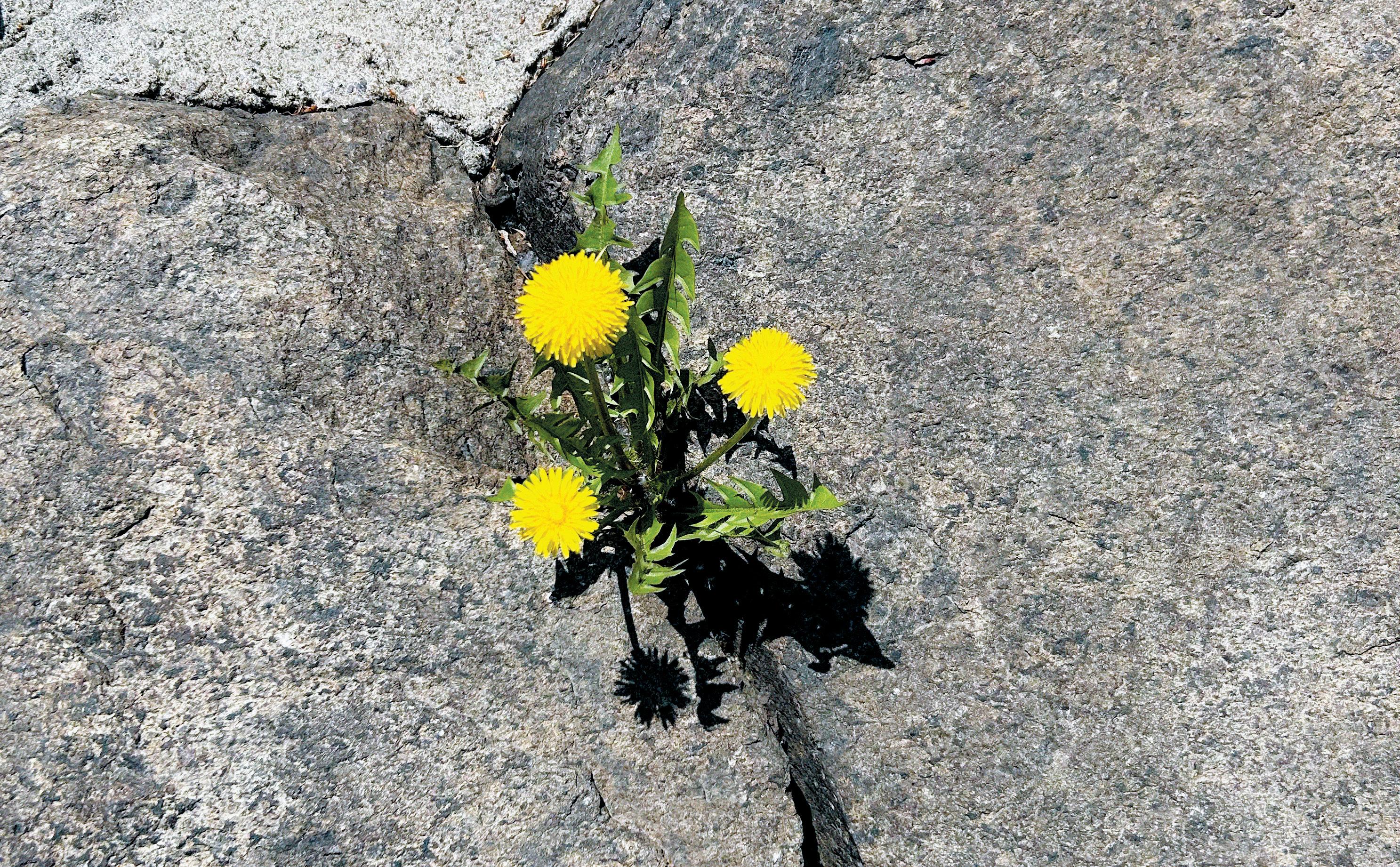
To learn more about friendship in adulthood, follow our podcast Centré sur l’équilibre, hosted by Evelyne Charuest.
The author of this article wrote the book entitled Ports d’attache : osons révolutionner nos amitiés ! published in February 2024 and available in all bookstores. All information presented in this article is taken from this work.
Sources
1 Norman, R. and Winston, B. (directors). (2021). Friends: The Reunion [special program]. HBO Max.
2 Hamelin, M., Doyle Péan, L., Peyrouse, A., Mackay, M., Corbeil, R., Nepveu-Villeneuve, M., Jacob, C., Alarie, V., Souissi, T., Gravelle, J., Michaud, M., Landry, M., Nyrva Aladin, F., Provencher, M., and Younsi, O. (2023). 15 brefs essais sur l’amour. Éditions Somme Toute.
3 DePaulo, B. (2006). Singled out: How singles are stereotyped, stigmatized, and ignored, and still live happily ever after. St. Martin’s Press.
With 29 studios, Idolem is a Quebec-based business founded in 2009 by Mélody Benhamou, a former professional beach volleyball player, yoga enthusiast, and accomplished young mother. Idolem makes yoga accessible everywhere and is suitable for all tastes and needs. Its inspiring instructors take the well-being of each participant to heart and devote themselves to their students with professionalism and expertise. The Idolem approach to yoga, which is practiced in heated rooms to increase the intensity of the workout and maximize its benefits, is intended to be dynamic and less static than typical yoga practices and aims to calm the mind by focusing on body and breath.
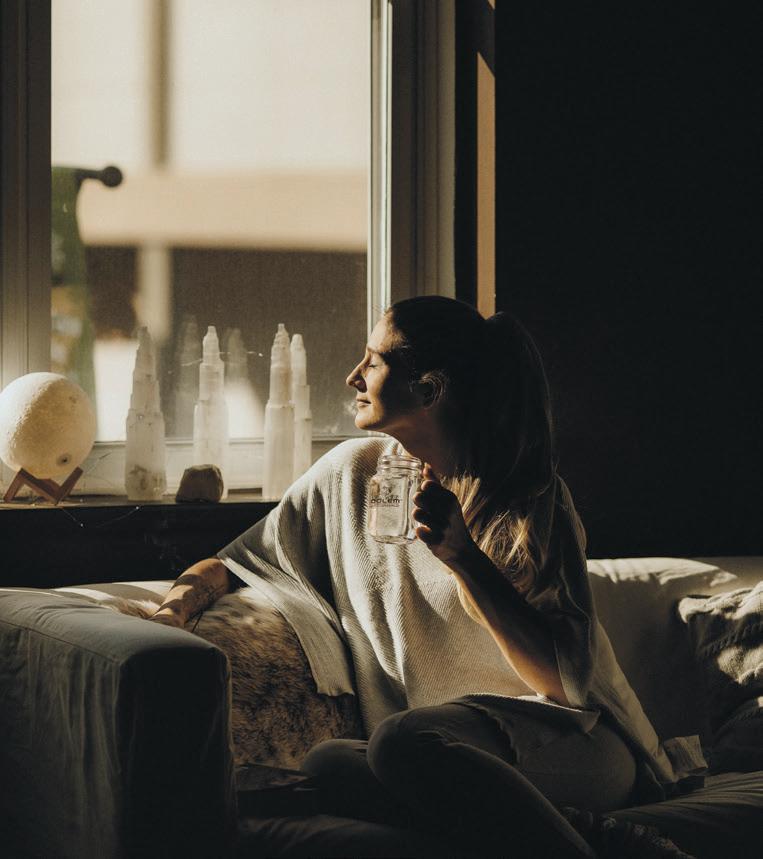
Idolem is much more than hot yoga. It’s a unique experience where everything is carefully implemented so that you can experience a magical moment from entrance to exit. Discover the six stages of the yogic spa circuit:
1. DETERMINE YOUR INTENTION Upon your arrival, Idolem invites you to draw a card at random from the magic deck provided to you in order to help you determine your intention for the day’s practice. The back of the card also serves as an indication to the instructor during class if you prefer to avoid any physical adjustments on their part.
2. LET GO WITH TEA-RAPY Take the time to savour a cup of tea prepared by our tea master, the flavours and properties of which echo the benefits of yoga. At this time, you can also reserve a regenerating juice, which will be waiting for you at the end of your circuit.
3. PREPARE THE BODY WITH THE SALT WALL This pure and Zen area allows you to enjoy the benefits of gentle halotherapy. Like a seaside getaway, it clears the airways and soothes the nervous system.
4. RELAX WITH HOT YOGA Take your place in our yoga room heated with radiant energy and let yourself be enveloped by its comfortable atmosphere. Our attentive instructors will guide you through a practice focused on listening to yourself, without comparison or judgement. To conclude the session, enjoy the well-deserved rest of Shavasana as the lights are dimmed and a cool towel scented with essential oils is gently placed on your face.
5. EXPERIENCE THE THERMAL CONTRAST After the heat, immerse yourself in the cold and work on your endurance in addition to enjoying the benefits of hot-cold alternation. One minute in the cold tub followed by five minutes of warming up, accompanied by our team.
6. FINISH WITH RELAXATION To conclude the circuit, take a nice, invigorating shower and let yourself go in the coolness of the water. Did you know that it is crucial to nourish your body within 20 minutes of physical exertion? As you sip your personalized healthy juice, which will help regenerate your muscles, you will give your heart rate and blood circulation a chance to return to normal, facilitating the transition to the rest of your day.
Try the yogic spa circuit at one of our 29 studios in Quebec and join thousands of devotees. Multi-city memberships are available, so you can find Idolem wherever you want.

Enjoy 15% off our memberships for 20 classes or more (excluding promotions) with promo code Strom24
Close your eyes. Open your senses.

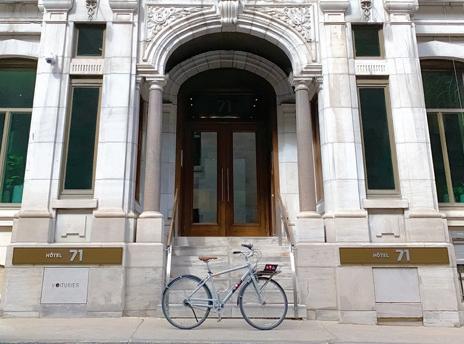





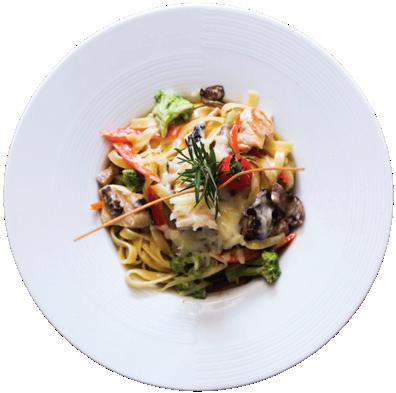
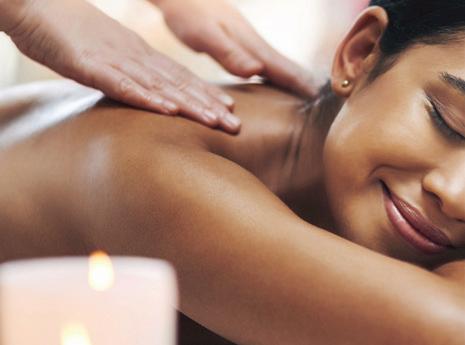
H71 and Strøm Nordic Spa invite you to let it all go. Calm and relaxation await you in the heart of the Old Port of Quebec. Discover our packages. hotel71.ca


Crafted with care and passion, our unique products create magical moments.
The Carnaval de Québec needs no introduction. The largest winter carnival in the world, its 71 st edition will take place from February 7 to 16, 2025.
For 10 days each year, Quebec City plays host to a real snow festival where more than a hundred festive, cultural, sporting, and culinary activities, as well as performances, ice sculptures, light shows, and the famous Bonhomme Carnaval liven up the city. Whether it’s warm or cold, snowing or not, the show will always go on!
1. PALAIS DE BONHOMME As majestic as it is impressive, the Palais de Bonhomme, made entirely of ice, is erected in honour of the King of the festival. From one year to the next, its shape is completely redesigned, and it usually takes two weeks to construct. Fun fact: In 2024, 3 100 blocks of ice, each weighing 300 pounds (approximately 136 kg), were needed to build this impressive ice castle. More than 900 000 pounds (more than 400 000 kg) of ice were therefore necessary for its construction.
2. NIGHT PARADES An activity popular with both young and old, the famous Carnaval de Québec night parades invite you to come sing and dance with more than 300 local artists.
3. SHOWS UNDER THE DOME No matter what kind of music you listen to, you will be enchanted by the musical evenings under the giant dome.
4. ICE CLIMBING BEAR Extreme sports enthusiasts can test their climbing skills by scaling a majestic 45-foot-tall polar bear.
5. ICE AND SNOW SCULPTURES Admire dozens of ice and snow sculptures, as magnificent as they are ephemeral, specially designed for the event.
Pick up the Effigy tag, your pass to access the Carnaval sites, starting from October during the pre-sale. Access to the Carnaval is free for children aged 12 and under. You can also treat yourself to a VIP experience during the night parades and the canoe race thanks to privileged experiences: prime seats to watch the show and refreshments await you. Joyeux Carnaval!
6. ICE BARS AND FESTIVE EVENINGS From the very beginning, the Carnaval de Québec has been an event that celebrates the joys of winter and the warm and festive side of Quebecers. Have fun among friends and enjoy the Ponce du Carnaval (a warm iconic cocktail) or other specialties in ice glasses.
7. CANOE RACE Cheer on the valiant and courageous canoeists during the great athletic challenge that takes place on the icy waters of the St. Lawrence River. An activity you need to see at least once in your life!
Enjoy 15% off our tie-in products (excluding privileged experiences) online until February 6, 2025, with promo code Carnaval15
To put yourself in the mood right now, listen to the new carnival songs.




By Vanessa Bell, writer
Scan the code to listen to the music of Arvo Pärt while you read.
I hear the heavy breathing of the bodies I love in each of the bedrooms leading to the kitchen. This moment is a privilege—that of solitude among dreams. The household is asleep in the warmth unique to the end of the night, and a faint orange light illuminates my work surface where I sort the leaves to place in my teapot as hot water boils on the stove. Between the aromas of tulsi and peppermint, I look up to see a heavy snow falling in slow motion in the black city sky. I think of Arvo Pärt. His music would be the perfect soundtrack to accompany this warm moment of calm.
With one hand, I pick up the snack I prepared the night before; with the other, I put the lid on my thermos. I stuff everything into my waterproof bag beside my neoprene mittens and boots, my towel, and a spare pair of socks. I’ve already put on my swimsuit, which I’ve covered with bulky jogging pants, a merino cardigan, and a fleece. I tiptoe down the stairs, swing my coat over my forearm, and open the door. A strong wind blows into the house. I smile wide.
In the car, the dashboard clock reads 5:32 a.m. I take the road between the snowdrifts which follow the shapes of the wind. In a few minutes, the river appears to my right. The freeway is deserted; only a few truckers heading toward the North Shore yawn, coffee in hand. I drive toward the mountains, toward one of the rivers I know is fast enough not to freeze over in the winter. I’m glad I have, as always, snowshoes and a sled in the car. Over the years, winter swimming has become, for me, not just an activity, but a way of life. In the trunk of my car, I always find a cord of wood, some kindling, everything I need for cooking, a sleeping bag, two axes, a well-used kettle, some tea, a shovel, and other tools to help me out in case of a breakdown. With this setup, I can follow my whims and go for a hike whenever I want.
Arriving at the place I know from cycling in the summer, I park my car and start loading the sled. I check twice that I have everything I need and put on my coat, neck warmer, toque, and mittens. I add a fluorescent bib to my winter outfit and head into the woods on a snowmobile trail. The snow there is more compact and makes it easier for me to get to the river. At this time on a weekday, I expect to encounter more wild animals than people. Since I started walking, I’ve already counted two hares with white fur. The snowflakes
resume their dance as I arrive at the spot for my swim. The deep blues have turned to grey. In its waltz, the snow is the conductor of the forest, imposing an enveloping silence that would soothe all broken hearts.
Here, in this ceremonial silence, I start setting up my temporary camp. First, I need to find a place near the river that is not on the ice. The first thing that makes it possible to enter the water in the winter is to know its body and bed beforehand in all seasons. Even though the river is lined with snow, I know its banks, and I can guess that some advancesare brittle or that they are not its real borders, but rather temporary islands of ice.
To avoid having to walk for a long time when I get out of the water, I choose a location near my entrance to place my things. With my feet, I stamp the snow to create the bed for the fire. Since I don’t know the thickness of the white blanket, I try to compact it as much as possible to avoid losing my fire in it while it burns without me. In the winter, some operations are more difficult than others due to the cold. I’ve long since abandoned my pride of starting all my fires naturally, and I use a lighter to keep my fingers from freezing in the cold wind that often blows through the corridors formed by the rivers. Quickly, mesmerizing flames dance before my eyes. As I watch over my heat source, I begin to prepare for my outing.
The thermos of tea and my snack await my return on the wool blanket with which I’ve covered the ground. I take off my mittens, then all my clothes, from bottom to top. As I remove them, I pile them on the sled in a very specific order that will quickly allow me to get warm and dry after my swim. I slip my feet into the boots and my hands into the mittens.
This morning is quite cold despite the snow; my thermometer reads -22 degrees Celsius. Before even entering the river, I choose to keep my toque on to avoid losing too much heat. Carefully, I advance toward the current. The water shimmers in a thousand places thanks to a clearing in the sky, while a great gust of wind makes the snow swirl near the water.
I crouch down. Put one leg in, then the other. My feet touch a large rock which, when summer comes, is exposed and becomes an unparalleled lounging spot. I know this bottom. This certainty gives me confidence, so I take a deep breath and turn my body toward the descent. As I exhale, I immerse myself up to my shoulders and raise my eyes toward the tops of the swaying spruce trees. I breathe in again, letting in all my love for this moment. I exhale, giving back to the land. Again and again. As long as I feel safe. I breathe deeply. I know the grandeur of what awaits me once I get out of the water. The ecstasy to come, courtesy of the endorphins that will follow.
But for now, I’m here, as I should be.
I’m no longer on the land; I, too, am the land.
And then, that’s everything.
Of course, there’s a long list of the benefits of Nordic swimming, including improved mood and pain tolerance, reduced stress levels, and a strengthened immune system, to name just a few. But the most important thing for me isn’t the regulation of my nervous system or the measurement of my physical and psychological abilities. What matters, after getting up in the night, walking through the forest, and watching the river and the shades of blue, is the reiteration of my place in the course of life.
We love what we know.
We protect what we love.
Through my swimming, I actively participate in protecting the land.



By Ariane Martel Labrecque, decluttering specialist and founder of Allo printemps
A few years ago, I knew someone who was being pushed out of his home by all the things he owned, as if chased off by the stifling abundance and compact disorder that covered every surface of his apartment.
It was an ordinary mess, made up of a thousand little decisions constantly postponed and fueled by a thousand little fears. The remains of a changing life in a paralyzing heap, here on the table, there on the floor.
I remember the clothes strewn on the floor, the jumble of papers and little pieces of trash on the kitchen table. The fridge filled with Mason jars that threatened to toss their lids like Frisbees across the kitchen under the effect of fermentation ignored for too long. I see him again, standing in the middle of the crowded room, holding in his hands the souvenirs of a trip he hadn’t taken, brought back by an ex who had left him three years earlier. He stood there, motionless, surrounded by the remains of his past projects: a dead kombucha starter at the bottom of a jar and broken musical instruments.
I remember books, everywhere. Pressed against each other on a long shelf above the sofa, there were books that had influenced him and nourished his love of literature, as well as philosophy books that he kept, as he told me, to seem intelligent. There were books he had started but never finished, which imposed themselves on him with insistence like so many crushing tasks on an old to-do list. Finally, hidden in a corner of the office, there were university textbooks to which he seemed to have entrusted a part of himself—the prospect of another life, placed for two decades on the back burner of possibilities.
“Abundance no longer opened up possibilities; on the contrary, it crushed them.”
When I met him, the chaotic abundance of the apartment took up all the space. The heavy accumulation of books had taken away his desire to lie down on the couch with a novel. The clutter on the counters no longer allowed him to undertake the cooking projects that seemed to bring him so much satisfaction. And the surfaces on which he could have set up his computer to work and create now displayed a multi-layered disorder hostile to concentration.
Over time, the excess—steeped in fatigue and fueled a little more each day by discouragement—became increasingly dense, increasingly complex to tackle, increasingly confronting. He had gotten into the habit of eating all his meals at a restaurant. He no longer dared to invite anyone to his house. However, he knew that when he opened the door to his home in the evening, he would be greeted by despondency and anxiety at what had become obvious: all the things he had held onto until now, all the things he thought defined him and allowed him to lead a rich, full life—these things were now suffocating him. Abundance no longer opened up possibilities; on the contrary, it crushed them.
This guy was the friend of a friend, and one day, he wrote to me asking me to help him “organize his life.” Helping people declutter is what I’ve chosen to do. It’s a job I love, because it gives me energy and allows me to be in the heart of the action, but above all, because it places me on the exhilarating threshold of new beginnings.
On the morning of our first day of decluttering together, we were sitting outside on the steps of the duplex where he lived. He looked both overwhelmed and annoyed, but I think he was a little afraid, too. To help him pull himself together, I remember telling him to act as if nothing inside the apartment belonged to him anymore. As if he were free to leave it all behind, if he wanted to. The image took effect: he deflated as if an enormous pressure had just left him. It was as if he could see himself on the other side of this exercise, in a world where he didn’t feel guilty or responsible for a bogged-down apartment. So, he plucked up his courage, and we headed inside.
For practical tips on decluttering, follow our podcast Centré sur l’équilibre , hosted by Evelyne Charuest.
Over the weeks that followed, we tackled the excess room by room. We sorted through camping gear, collected important papers, and made piles of books to give away or return to their owners. We threw out almost everything in the fridge and managed to get the kombucha starter out of its jar. We donated musical instruments and clothing, dragged furniture out to the sidewalk, and identified tasks to be completed in order to keep moving forward.
Each day, he faced a flurry of decisions and went through all sorts of little periods of mourning, but in the same breath, he defined a new version of himself, clearer and more honest. He raised his head and regained his power. Each day, he felt a little lighter, prouder, and more confident of the work he had started on his knees and finished standing, galvanized by this transformation and his ability to transform himself again. *
Several years later, I sometimes cross paths with him in my neighbourhood. He often tells me how liberating the decluttering we did together was. That it allowed him to build a positive self-image and see himself in a future that really suited him. And hearing that is nourishing for me. It’s what drives me to seek out my place on the threshold of new beginnings, on that bright tipping point toward greater freedom.



By Marie-Ève Trudel, wellness contributor
As more is learned about the different phases of the menstrual cycle and their impact on women’s energy levels, moods, and needs, one idea stands out: Why don’t we adapt to our cycle rather than fighting against it in order to be productive at all costs? Why couldn’t we observe the natural predispositions that each phase offers us in order to take advantage of them instead of seeing them as obstacles that take us away from our goals? Living in harmony with our cycle is a totally natural way to promote our well-being.
This idea is making its way around the world, especially in the United States, where hormonal health experts such as Maisie Hill, author of Period Power and Perimenopause Power, and Alisa Vitti, founder of FLO Living, are singing the praises of cycle syncing, which involves adjusting your lifestyle, diet, and beauty rituals according to the phase of the menstrual cycle you are in.
This approach is also quietly gaining in popularity in Quebec, as noted by women’s health expert Cynthia Marc-Aurèle: “Tracking your cycle is the first step to regaining control over your well-being. It allows you to understand your body better and meet its needs more effectively.”
The menstrual cycle, which lasts 28 days on average (between 24 and 38 days, more specifically, since only 10 to 15% of women have a cycle that lasts precisely 28 days), is divided into four main phases: the follicular phase, which begins on the first day of menstruation and therefore includes the menstrual phase, the ovulatory phase, and the luteal phase.
“ Living in harmony with our cycle is a totally natural way to promote our well-being.”
Although each phase has its own unique characteristics, it is important to remember that their duration and effects can vary from one person to the next. This is why the key is to observe your rhythms and get to know yourself.
MENSTRUAL PHASE This phase marks the beginning of the cycle, where decreased estrogen and progesterone levels cause the shedding of the uterine lining. In addition to bleeding, common symptoms include stomach pain, headaches, nausea, and diarrhea. This phase lasts from two to eight days on average.
FOLLICULAR PHASE After menstruation, estrogen and progesterone levels increase, stimulating the development of the ovarian follicle. This phase lasts approximately nine days and is marked by renewed energy and an increasingly good mood.
OVULATORY PHASE Lasting approximately three days, this phase is marked by an estrogen spike and increased progesterone when the egg is released. This is the phase where pregnancy is most likely and sexual motivation is highest.
LUTEAL PHASE This last phase of the cycle, lasting approximately ten days, is marked by high estrogen and progesterone levels, which decrease if pregnancy does not occur. This phase is often associated with increased anxiety, difficulty concentrating, and symptoms of premenstrual syndrome (PMS), including irritability, anxiety, a bad or depressed mood, headaches, and breast pain.
The first step in cycle syncing is to track your cycle and learn to recognize its different phases. A notebook and a traditional calendar can be used to keep track of dates and feelings, but there are also apps to make our job easier, such as the Flo Period Tracker, Wild.AI: Hormones & Fitness, or Spot On Period Tracker.
A study from the Harvard Faculty of Medicine revealed that a regular yoga practice tailored to the phases of the menstrual cycle could triple the success rate of pregnancies by in vitro fertilization after three months of twice-weekly practice. This study highlights the importance of adapting physical activities to hormonal fluctuations in order to optimize women’s health and well-being.
Among the many strategies that contributed to the victory of the U.S. women’s soccer team at the 2019 World Cup, one of the most unusual was taking the players’ menstrual cycles into account. The team therefore developed a strategy to work according to each player’s cycles, allowing more recovery time during phases where energy was scarcer.
Then, to adapt to your menstrual cycle, you need to understand that the hormonal fluctuations throughout the cycle influence physical performance, but also the body’s nutritional needs and the skin care routine to be favoured. Here are the right practices to adopt, phase after phase:
DURING THE MENSTRUAL PHASE
Practice light exercises such as yoga, walking, or stretching to respect your body’s need for rest.
Eat iron-rich foods such as nuts, lentils, and meat to replenish your reserves following the blood loss. Omega 3s and vitamin B12 are also beneficial to reduce inflammation and combat fatigue.
Use a gentle cleanser and a rich moisturizing cream to care for your skin, and carve out space for hot baths and relaxing massages in your daily routine.
DURING THE FOLLICULAR PHASE
Practice more intense physical activities such as cardio or Zumba, since your energy is returning.
Eat foods rich in fibre and zinc, such as eggs and whole grains, to support your body as it prepares for ovulation.
Use a scrub and a repairing serum to help the epidermis regenerate.
DURING THE OVULATORY PHASE
Perform high-intensity workouts, as your energy level is at its peak.
Eat fibre-rich foods to maintain a good hormonal balance.
Use light skin care products and purifying masks.
DURING
Practice exercises focused on mental well-being, such as yoga or meditation, to counter anxiety and fatigue.
Eat foods rich in healthy fats, such as avocados and nuts, and slow carbohydrates, such as sweet potatoes and beans. These will help stabilize blood sugar levels and maintain constant energy.
Use deep moisturizing creams and soothing serums.
Platforms such as Alo Moves offer online courses tailored to the different phases of the menstrual cycle, allowing women to follow routines adapted to their daily needs.
Sources
McLaughlin, J. (2022, April). Le cycle menstruel . Merck Manuals. https://www.merckmanuals.com/fr-ca/accueil/ probl%C3%A8mes-de-sant%C3%A9-de-la-femme/biologie-de-l%E2%80%99appareil-g%C3%A9nital-f%C3%A9minin/le-cycle-menstruel
Domar, A. and Kelly, A. L. (2004). Conquering Infertility: Dr. Alice Domar’s Mind/Body Guide to Enhancing Fertility and Coping with Infertility. Penguin Publishing Group.
Kindelan, K. (2019, August 8). How tracking their periods helped USA women’s soccer team win the World Cup. ABC News. https://abcnews.go.com/GMA/Wellness/uswnt-periodtracking-win-world-cup/story?id=64709450
Pinkerton, J. (2023, February). Syndrome prémenstruel (SPM). Merck Manuals. https://www.merckmanuals.com/fr-ca/ accueil/probl%C3%A8mes-de-sant%C3%A9-de-la-femme/ troubles-menstruels-et-anomalies-du-saignement-vaginal/ syndrome-pr%C3%A9menstruel-spm
1. ACHIEVING GOALS Adapting your activities and commitments to the different phases of the cycle can help you be more efficient and successful.
2. INCREASED INTUITION A better mindbody connection helps you better understand your needs and adequately meet them.
3. IMPROVED MOOD A daily routine tailored to the hormonal cycle reduces stress and improves your overall mood.
4. REDUCED PMS SYMPTOMS A balanced diet and an adapted lifestyle help reduce the unpleasant symptoms of PMS.
5. IMPROVED RELATIONSHIPS Knowing when to be active and when to rest improves personal and professional interactions and helps you preserve your energy when moments of solitude are more appropriate.
6. STRENGTHENED SELF-ESTEEM Taking care of yourself and listening to your body strengthens self-confidence and self-love.
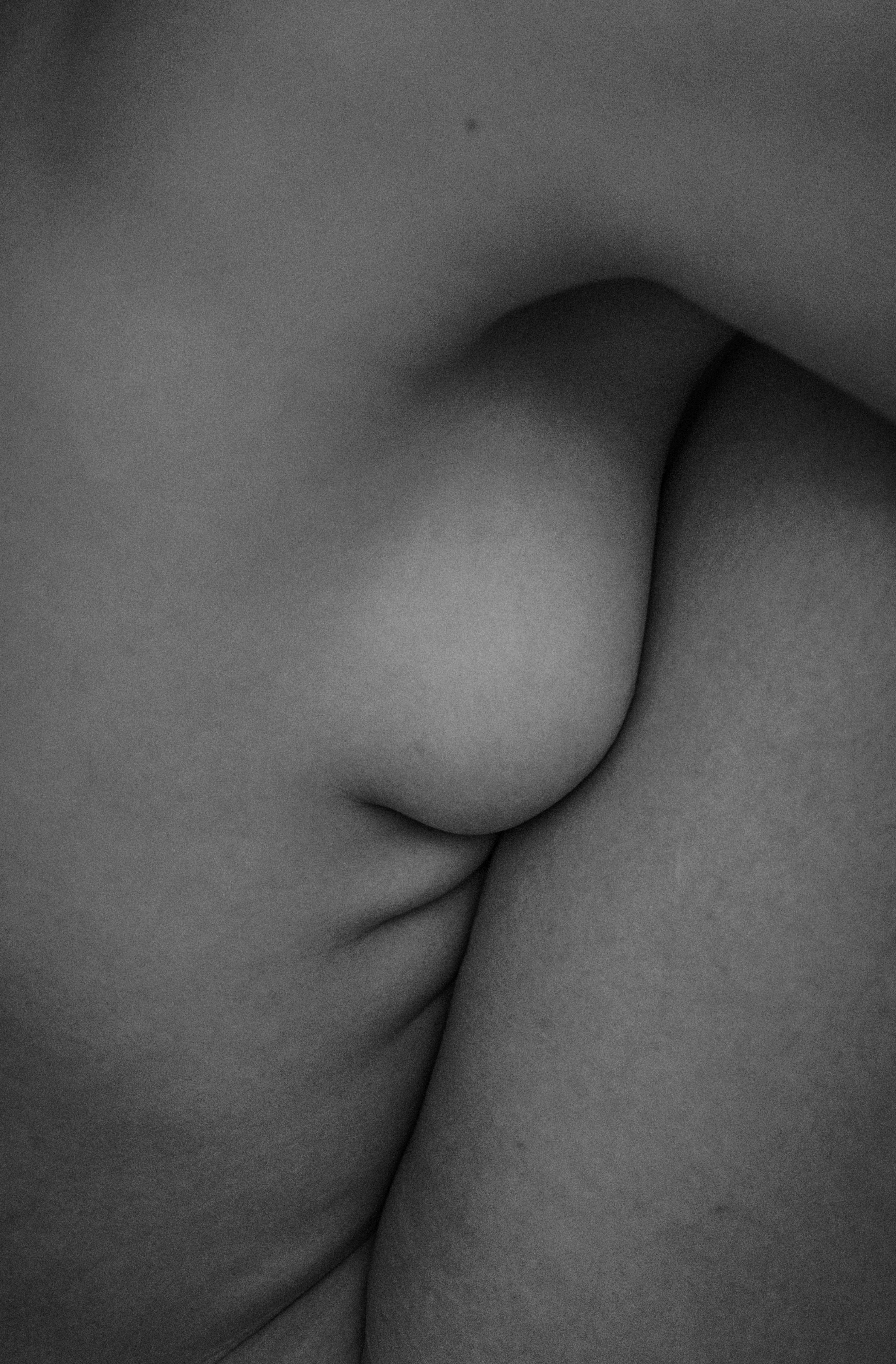
In short, living according to your cycles means giving yourself permission to fluctuate and be inconsistent. It’s an act of kindness toward yourself. By accepting these changes, we get to know ourselves better. It’s a return to an ancestral wisdom and a deep respect for our cyclical nature.
In this dance with our cycles, we rediscover a part of ourselves that has long been ignored and often judged. We understand that each phase has its beauty, strengths, and weaknesses. Cycle syncing therefore becomes an art of living, a way of taking care of ourselves in depth and honouring this body that carries us through life.
You ensure balance around you; let us be yours for a moment.

Every year, more than 500 caregivers visit one of our establishments to recharge their batteries.

What makes a visit to the spa so charming, among other aspects, is the plurality of experiences offered there, which can be enjoyed in the order of your choice, to create a personalized journey that meets your needs and desires. To allow you to recreate your favourite experiences in the comfort of your home, Strøm offers carefully designed products at its stores that evoke relaxation and invite well-being. Here are five products or product sets to discover now, so you can recreate the soothing journey you love so much at home.
TO BE REPLICATED: THE OLFACTORY SIGNATURE OF STRØM NORDIC SPAS
1,2. With: Essential oil of eucalyptus or eucalyptus room mist
Recreate the olfactory signature of our spas at home.
Essential oil of eucalyptus is the quintessential scent of relaxation. Beneficial for the airways, it is at once invigorating and soothing. To be diffused during a moment of cocooning, upon waking to start the day off right, or all night long in the bedroom.
For more ways to enjoy this popular fragrance, you can also try our eucalyptus room mist. It purifies the air and delicately perfumes the room. It is made from pure, organic essential oils of eucalyptus radiata, balsam fir, peppermint, copaiba, and fine lavender. Benefit from its decongestant and toning properties all day long!
TO BE REPLICATED: THE STRUCTURING AND DRAINING ACTION OF A FACIAL TREATMENT
3. With: gua sha ritual porcelain
Hand-sculpted in Quebec, the gua sha self-massage porcelain tool defines the contours of the face, promotes blood circulation, and gives a radiant glow to the skin. It is used in combination with a skin care oil such as the face, body, and hair ritual oil. Add it to your kit to enhance your skin care routine.

Try them! From October 15, 2024, to April 15, 2025, get free delivery on all products purchased from our online store with promo code MAGAZINE19

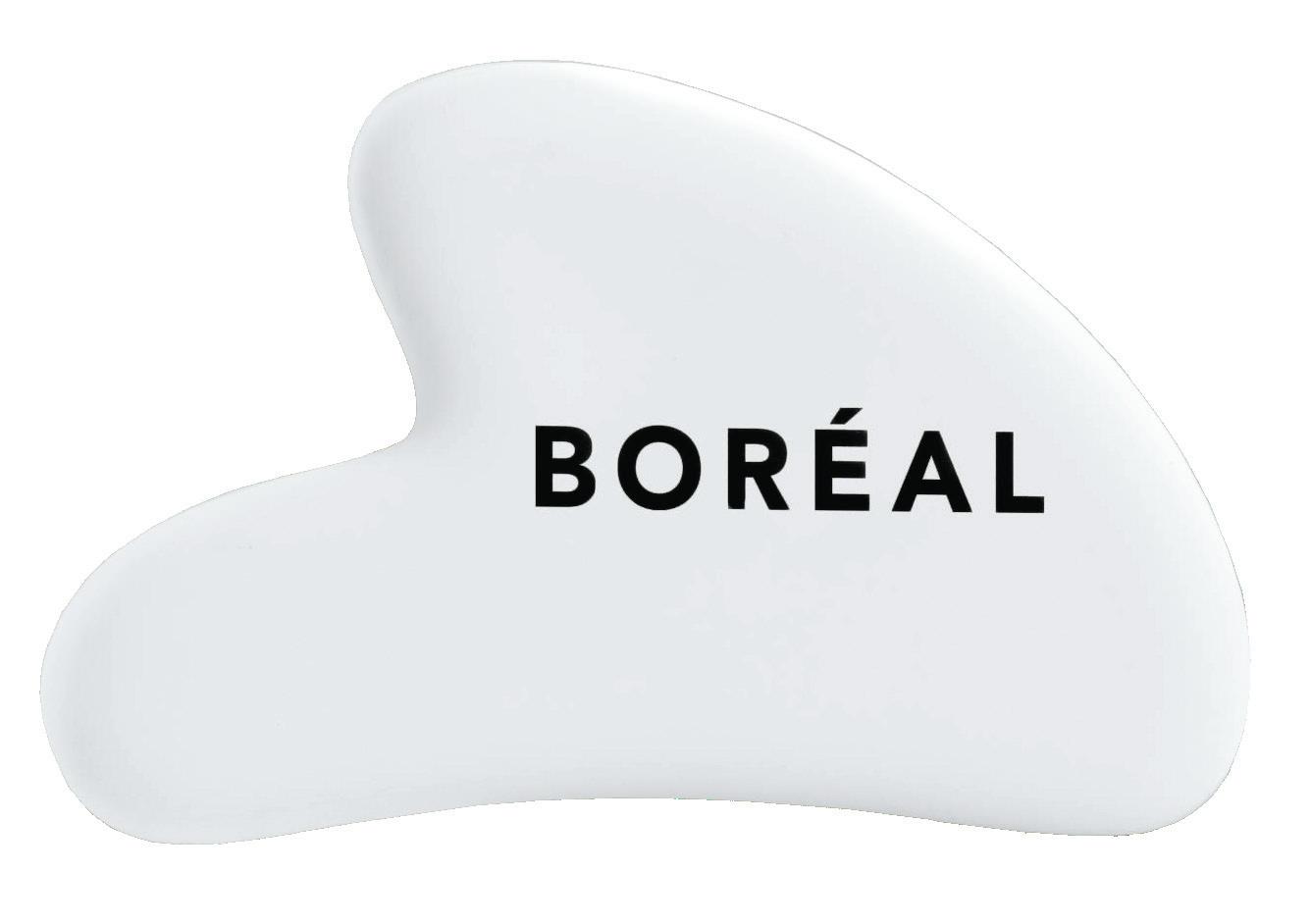

TO BE REPLICATED: THE ENVELOPING AROMA OF THE SHOWER AT THE END OF THE THERMAL CIRCUIT
6. With: shower kit
Nothing is better than a nice shower to warm up after enjoying the outdoor thermal circuit in the winter. To savour the delicate fragrance of Strøm Nordic Spa’s signature shower products day after day, pick up the shower kit, which includes the shampoo, conditioner, and shower gel. Containing essential oils of eucalyptus, black spruce, lavender, and pine, they gently moisturize and deeply clean the skin and hair, in addition to making shower time a true olfactory experience.
TO BE REPLICATED: THE BENEFITS OF MASSAGE THERAPY
4. With: Relaxation massage gel
This massage gel with aromas of sweet orange, Ho wood, and cypress will allow you to maintain the feeling of relaxation and letting-go offered by a massage therapy treatment at one of our establishments. It can also be used for self-massage to release tension at the end of a busy day.
TO BE REPLICATED: A TREATMENT WITH PURIFYING AND MOISTURIZING PROPERTIES
5. With: Sea salt scrub
Exfoliation is an essential gesture when the time comes to care for your skin. As part of a visit to the spa, it is ideal after enjoying the thermal circuit to detoxify the epidermis. At home, get inspired by the ritual offered in the exfoliation spaces at Strøm spas: a salt scrub, a skin massage, then a rinse with plenty of water.


Made with sea salt, grapeseed oil, and essential oil of eucalyptus, this scrub not only helps remove dead skin cells, but also activates blood circulation and eliminates toxins. Its properties help relax and soothe aching joints and muscles. A wonderful addition to the traditional thermal circuit.
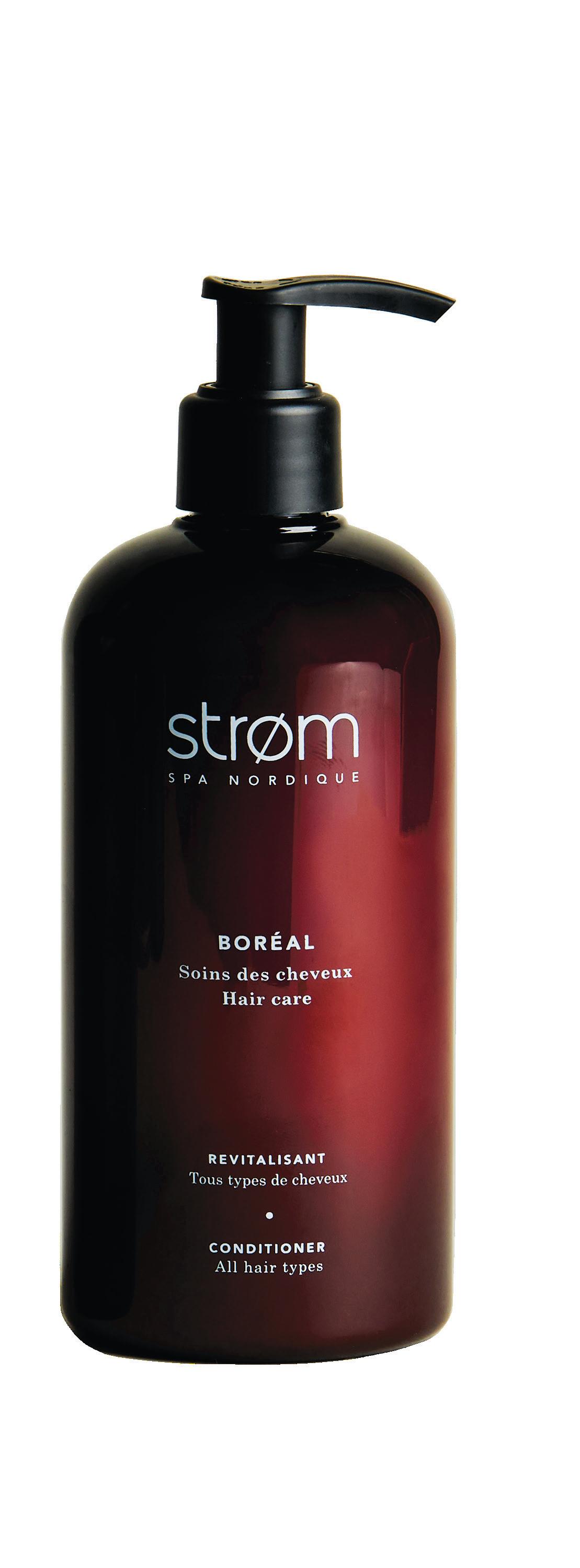

By Dr. Lory Zephyr, psychologist
If you’re a parent, you know all too well that back-to-school time is the equivalent of an ultramarathon. Buying the items on the school list, registering for various extracurricular activities, checking that their clothes are still the right size, labelling their belongings… And it doesn’t stop there! You also have to catch up on all the unread emails during your vacation, reconnect with team meetings to continue the year properly, and dive back into your to-do list. Unfortunately, exhaustion often awaits us at the end of this sequence, even though the school year has only just begun. If you recognize yourself in this scenario, you’re not alone in experiencing it.
Indeed, a report published in 2023 following an investigation conducted by ConciliviRéseau pour un Québec Famille shows that in Quebec, work-life balance remains a significant source of stress for a majority (66%) of parents of young children. It should be clarified here that work-life balance refers to the search for balance between the requirements and responsibilities related to work life and family life. The imbalance reported by many parents corresponds rather to work-family conflict. This lack of balance is not without risk.
For example, certain studies report that work-family conflict situations are associated with anxiety and mood disorders in women, whereas in men, they are related to an increase in alcohol dependence and drug use. In addition to having mental health effects, work-family conflict can negatively affect physical health, lifestyles, romantic relationships, and feelings of parental competence. Furthermore, the parent-child relationship can suffer; certain studies show that parents who report experiencing more tension related to work-life balance are at greater risk of shouting, raising their voice, getting angry on a daily basis, and losing their patience when their children ask for attention.


TIME CONFLICTS: These happen when the requirements of the different roles make time management difficult. For example, having to work until 5:30 p.m. while the daycare located 20 minutes away (without traffic!) closes at 6 p.m.
CONFLICTS RELATED TO TENSION BETWEEN ROLES: The more roles people take on, the more likely they are to suffer from pressure, a feeling of being overloaded, and stress. For example, being a worker, a parent, and a caregiver.
BEHAVIOURAL CONFLICTS: These appear when a behaviour specific to one role is incompatible with what is expected in another role. For example, having to be direct and authoritative at work when that’s the opposite of what you want to be at home.
Several other elements contribute to a high level of work-family conflict, such as the particularly fast pace of life in our society, the cult of urgency, performance pressure, and the increasing expectations of success that surround us.
There are a few ideas that can help you better reconcile your different roles and generally improve your well-being in the face of them:
THE STRENGTH OF FLEXIBILITY: Benefiting from a flexible work schedule will allow you to adapt to the vagaries of family life. At the same time, having support from those around you can help you meet the demands of work when they are less flexible. Taking the time to discuss your needs and expectations with your loved ones, as well as with your employer, can be an excellent starting point.
SLOW DOWN: Doing several things at once (multitasking) can be very tempting in order to accomplish everything you need to get done. However, performing two or more tasks at the same time is much more tiring for the brain than solving a single difficult exercise. To promote your well-being, it’s necessary to know how to block out distractions. So, there’s no point to ordering sushi over the phone while signing your eldest’s agenda and reading an email from your boss. Your brain will be overheated and less effective at managing each of these tasks. Learn to lower your expectations, make a to-do list, and tackle each task one by one. Meditation can be a good ally to learn how to focus on one thing at a time.
RETURN TO YOUR VALUES: Values are the basic principles that guide your life. They are like a compass that orients your choices and actions. Returning to what is most important to you can help you organize your schedule, which will correspond more to who you are. Defining five core values and writing them down somewhere visible on a daily basis could help you anchor yourself during moments where you feel caught in the whirlwind of work-life balance.
Values guide your behaviours, choices, and decisions. They reflect what you believe, respect, and deem important. However, if you don’t really know your values or don’t respect them, you may feel like you’re going around in circles in your life, searching for fleeting pleasures, or generally feeling less satisfaction, as an important element will be missing: meaning.
Thinking about your values may seem simple, but in reality, many people don’t know where to start to define them better. One of the first authors to take an interest in values is psychologist Shalom H. Schwartz. One of his theories posits 10 basic values (autonomy, stimulation, hedonism, success, power, safety, conformity, tradition, kindness, and universalism) from which other authors have started over time to expand the list. For example, adventure, freedom, and justice have been added.
To help you define yours, don’t hesitate to use an online search engine to find a list of values as well as their definitions. Take the time to carry out the exercise properly and think about what is important to you. That way, you can better anchor yourself in life.
Sources
Allen, T. D., Herst, D. E., Bruck, C. S., & Sutton, M. (2000). “Consequences associated with work-to-family conflict: A review and agenda for future research.” Journal of Occupational Health Psychology 5(2), 278-308.
Boulet, M. & Le Bourdais, C. (2016). “Pratiques de conciliation travail-famille et détresse psychologique des salariés québécois : une comparaison selon le genre.” Relations industrielles/ Industrial Relations 71(3), 442–467.
Institut national de santé publique du Québec. (2005). “La difficulté de concilier travail-famille : ses impacts sur la santé physique et mentale des familles québécoises.”
Vahedi, A., Krug, I., & Westrupp, E. M. (2019). “Crossover of parents’ work-family conflict to family functioning and child mental health.” Journal of Applied Developmental Psychology 62, 38–49.
BOOKS
Tremblay, D.-G. (2019). Conciliation emploi-famille et temps sociaux (4 th ed.). Presses de l’Université du Québec.
Ferland, F. (2021). Petit guide pour parents épuisés : Vers un quotidien plus serein . Éditions CHU Sainte-Justine.
PODCASTS
Lina, V. (host). (April 2021). “Ma place au travail avec Myriam Lapointe-Gagnon” (no. 21) [podcast episode]. In Parents pour la première fois
Zephyr, L. & Brazeau, J. (hosts). (September 2022). “Avoir hâte de retourner au travail” (no. 44) [podcast episode]. In Ça va maman ?
By Nicolas Gendron, cultural journalist
Because there isn’t just one way to accept the present, as the saying goes, and leave what’s passed in the past, here, brought together in these pages, are five literary or musical works that explore how—little by little or all at once—it’s possible to confront, overcome, or embrace what too often prevents us from moving forward.
La symphonie des éclairs, by Zaho de Sagazan (Virgin, 2023)
Celebrated at Victoires de la musique, where she won four of the most prestigious awards, including those for album of the year, female breakthrough artist, and original song (the enchanting title track), Zaho de Sagazan is, at 24 years old, in full command of her strengths from her first album. With her confident phrasing, mature voice, shroud of mystery, and taste for proud and complex pop, she deploys the full emotional palette that we need to master in order to flourish on a daily basis by assuming it with all our flesh. There’s love, of course, in its excitement (“Les garçons, Mon inconnu”), blindness (“Les dormantes”), grip (“Langage”), doubts (“Dis-moi que tu m’aimes”), or disappointments (“Je rêve, Suffisamment”). Sagazan also struggles with fear (“Ne te regarde pas”) or gloomy weather (“Tristesse”), asserting that “Les émotions sont des couleurs / [Elle est] le peintre qui les renverse ” (“Emotions are colours / [She is] the painter who turns them upside down”). Until crossing the clouds “comme le fait la lumière ” (“as the light does”), like a human storm releasing La symphonie des éclairs (the symphony of lightning bolts).
Le tour du bloc. L’album du spectacle, by Michel Rivard and the Flybin Big Band (Spectra Musique, 2023)
After surveying his star chart in the musical theatre show L’origine de mes espèces, former truck driver Michel Rivard allows himself to revisit 50 years of songs while questioning what it costs us to orbit the Sun. No fewer than 11 musicians and backing vocalists accompany him on stage, the famous Flybin Big Band, and his repertoire gains a breadth and magnificence that is most contagious. From “tour du bloc ” (“touring the block”) of his youth to those moments where the adult “fait tourner des ballons (sur son nez) ” (“spins balloons [on his nose]”), passing through the tricks that life plays on us directly, he encourages us to reconcile ourselves with our past without succumbing to nostalgia, that “maîtresse inassouvie aux yeux trop bleus ” (“unfulfilled mistress with eyes too blue”). Between the borrowings from Beau Dommage and the gems of his solo career, the songs resurface in disorder, like so many radiant memories “Tombé(s) du ciel” (“fallen from the sky”) through “Un trou dans les nuages” (“a hole in the clouds”). An album recorded in front of an audience that reshapes a “Maudit Bonheur” (“cursed happiness”) which should spill over onto everyone.


DEBTS
Le compte est bon, by Louis-Daniel Godin (La Peuplade, 2023)
What if adoption were the ultimate debt? A child now fully grown asks himself this obsessive question while dwelling on his core memories, encapsulating them in numerical values, from zero to twenty thousand, without forgetting infinity. Adopted when he was five days old, Louis-Daniel runs with all his soul after his credit note, deciphering each transaction into hard cash or symbolic currencies. With Le compte est bon , a wink at the French game Des chiffres et des lettres , first-time novelist Louis-Daniel Godin, keen on psychoanalysis, polishes a hypnotic writing style, magnetized by the call of the right word, which unfolds and folds back up, races forward and steps back, affirms and doubts in the same breath, empties the piggy bank without breaking it in order to better replenish it; “mais il faut avancer, il faut avancer quand même, sinon, sinon, sinon” (“but you have to move forward, have to move forward anyway, otherwise, otherwise, otherwise”). A little gem with a charming, controlled style, where figures take shape and give thanks to what will never be calculated.

WOUNDS
Nommer le vivant, by Mélilot de Repentigny (Leméac, 2024)
“De la vitalité à la dormance” (“From vitality to dormancy”) and vice versa and through all the natural states between these two poles, Myrique observes their environment according to the upheavals of their mental health. Because “il n’y a pas de meilleur remède à la grisaille que celui d’apprendre à nommer le vivant” (“there’s no better remedy for gloom than learning to name the living”), they rely on the perspective of Brother Marie-Victorin and his Laurentian Flora to identify and tame the species around them during their psychiatric stays, from Montreal to Rimouski. Having studied forestry techniques then developed a passion for picking all kinds of things, especially mushrooms, Myrique—the alter ego of Mélilot de Repentigny—paints nuanced and multidimensional portraits of the medical and nursing staff, but above all of their fellow hospitalized patients, on a territory where disorders and deficiencies, sap and sweat, insomnia and buried dreams abound. A first book that breathes deeply and forcefully reminds us that health is a matter of both movement and rootedness.

GOODBYES
Partir de loin, by Caroline Dawson and Maurèen Poignonec (La Bagnole, 2024)
Caroline is getting ready to board a plane with her children and takes the opportunity to tell them about her first flight, when she was only seven years old and had to leave behind not only almost all her toys, but above all, the country where she was born. A few months before her departure, the late Caroline Dawson published this beautiful children’s book in collaboration with illustrator Maurèen Poignonec, whose pencil strokes perfectly convey the liveliness specific to childhood. The author delicately addresses certain issues already raised in her famous story Là où je me terre, adapting them for young children and making no reference to Chile or to Spanish in order to broaden the readership’s horizons. Immigration and its multiple challenges, learning a language, preserving and discovering traditions—simply put, a new life takes shape, from school benches to the sugar shack, and another journey begins.






The boreal terroir is rich in unique flavours that are worth discovering. We have therefore brought together here some of the typical ingredients in the boreal pantry, which can be used fresh or dried depending on the season. As the boreal forest is full of treasures but also species that are harmful to your health, we encourage you to perfect your harvesting expertise using credible documentation or training on the subject before getting started.
1. Spruce needles
Spruce needles have a fresh, resinous aroma that lends a boreal forest flavour to salmon, stews, cocktails, and even desserts. In midMay, it’s possible to pick them in the forest. It is then recommended to rinse them in fresh water and baking soda.


2. Juniper berries
In the wild, juniper is mainly found on the edges of cliffs, along the seashore, and in coniferous forests. In Quebec, it is primarily found in the Bas-Saint-Laurent region, near the river. Aromatic, resinous, and slightly sweet, the juniper berry is the only spice that comes from conifers. Its distinctive aroma has been used for centuries to flavour gin, whose name is also inspired by this famous berry.
3. Wild caraway
Of European origin, wild caraway, also called “meadow cumin,” is a plant that resembles fennel, anise, and dill. Given their robust and complex flavour, wild caraway seeds are used sparingly to enhance certain dishes and cocktails.

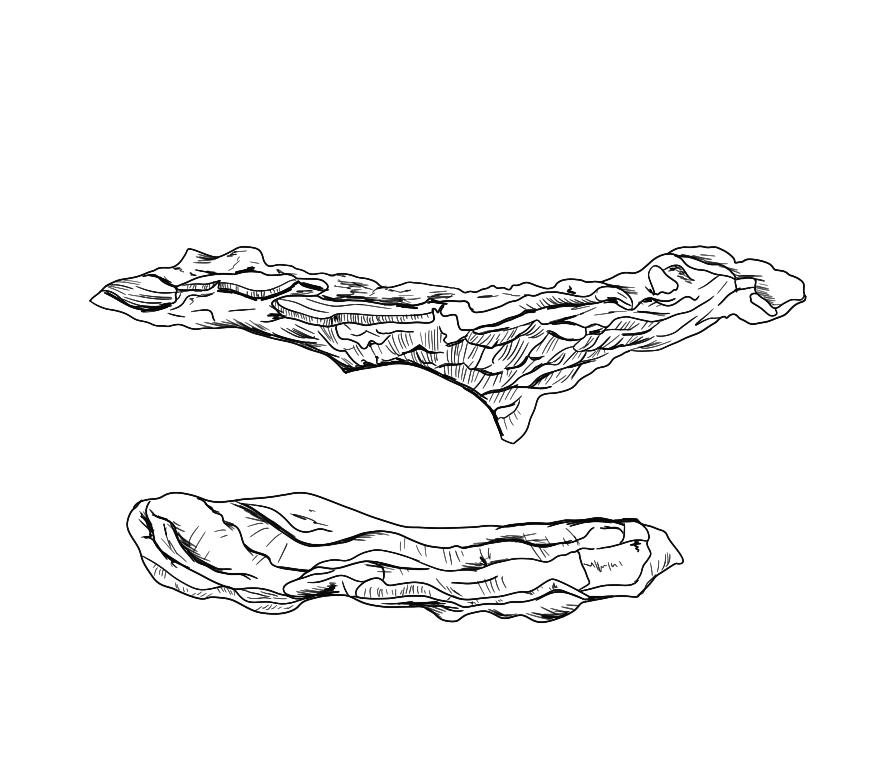
4. Chaga
Chaga is a mushroom from the boreal forest that grows on trees, especially birches. Rich in antioxidants, chaga possesses a multitude of medicinal properties. In cooking, it is used in decoction for its earthy, woody aromas and its sweet bitterness, which delicately enhances dishes.
5. Nordic spices
Nordic spices are a combination of various spices of your choice, such as dill seeds and leaves, fennel seeds, yellow mustard seeds, dried tarragon, cardamom, juniper berries, wild caraway, and other spices that come from the forest.

7. Lavender
Highly prized in perfumery, lavender flowers are also popular in cooking. Purple and very fragrant, they add a floral touch to drinks and dishes, whether they are sweet or savoury. It is important to make sure to choose edible lavender and to use it sparingly, since its taste is very strong.
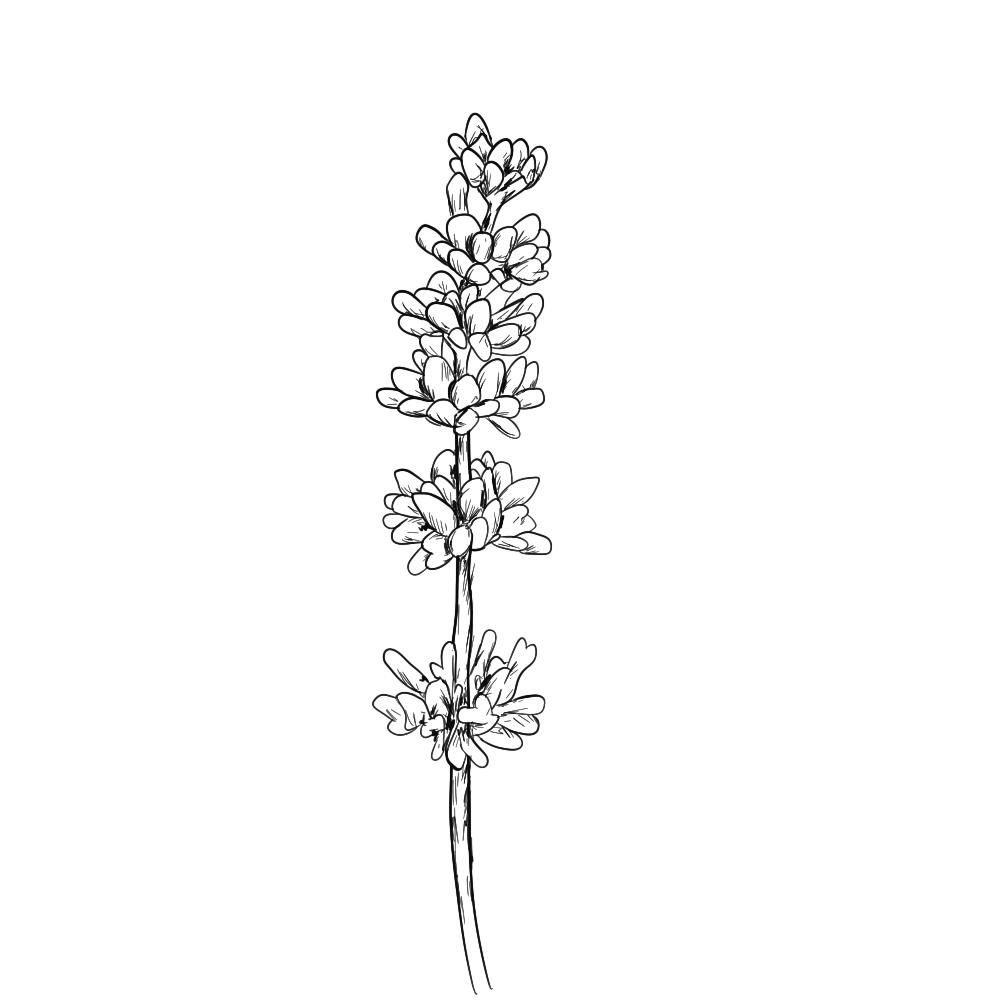

9. Spruce tips
Picked in the spring on the edges of forests, spruce tips have been appreciated for centuries, whether to produce spruce beer or cough and cold syrups. With a fresh, slightly resinous flavour with notes of citrus, they are ideal for hors-d’oeuvres, fish, game, salads, and cocktails. They mix well with juniper, pepper, and Labrador tea. If you pick your spruce tips in the forest, make sure that the conifer is far from any source of pollution or contamination.

6. Sweet clover extract
Sweet clover extract is obtained from the flowers of this wild plant which grows almost everywhere in Quebec. Its taste is reminiscent of vanilla and has notes of almond and freshly cut hay. Widely used in baking, this plant is even nicknamed “boreal vanilla.”

8. Lemon balm
Lemon balm is a plant native to the eastern Mediterranean basin which can be found in all temperate climates, including Quebec. Appreciated for its therapeutic virtues, lemon balm is often consumed as an herbal tea. The citrusy taste of its leaves also makes it a must-have for flavouring meat, poultry, fish, soups, and salads.
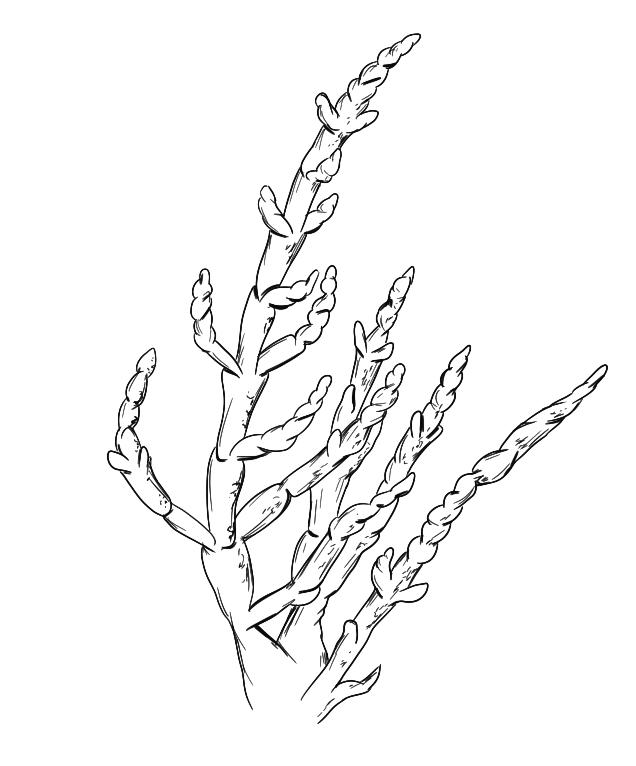
10. Samphire
Samphire is a wild plant that grows in salt marshes and by the seashore. In Quebec, it can be found on the banks of the St. Lawrence River, from La Pocatière to Gaspésie, in Chaleur Bay. This crunchy plant with a salty taste is often used to accompany fish or seafood dishes. Like seaweed, samphire is rich in vitamins and minerals.

11. Birch syrup
Like maple syrup, birch syrup is obtained from trees in the forests of northern Europe and America. Less sweet than maple syrup, its scent is reminiscent of caramel with a touch of spice. Birch syrup can be used in desserts, as well as in savoury fish, meat, and vegetable dishes or salads.

12. Labrador tea
Present in the tundras, bogs, and forests of North America, Labrador tea has been used for centuries, particularly for its therapeutic properties. It is consumed as an infusion, but is also used to season dishes with its delicate, vegetable-like flavour.
13. Lingonberries
Small, tangy red berries with a taste similar to that of cranberries, lingonberries grow in the wild throughout the mountainous regions of North America as well as in Scandinavia.


14. Sea buckthorn
Bright orange in colour and native to Europe and Asia, sea buckthorn started to be cultivated in Quebec in the early 2000s. Perfectly suited to our northern climate, it can be found in windbreak hedges, along roads, or as an ornamental shrub. This berry has a sour, astringent taste which is similar to that of passionfruit.
15. Rose hips
Rose hips are wild rose bushes that produce large red berries after they flower. They can be found everywhere along the waterways of Quebec. At one time consumed by Indigenous peoples in the form of therapeutic herbal teas, these berries are now used mainly in jams, jellies, marmalades, syrups, and liqueurs, alone or mixed with other fruits. It is important to wash and strain these berries to eliminate their seeds and hairs, which are irritating.


Nordic berries include various native berries that grow wild (in forests or clearings) or are cultivated, including wild blueberries, lingonberries, Saskatoon berries, cranberries, raspberries, blackcurrants, chokeberries, and elderberries. You have to pay attention, because certain toxic species resemble these wild berries.

Native to Japan, Haskap berries can be found in the wild near the wetlands of Canadian boreal forests, but their cultivation has only recently been established in Quebec. Its name means “berry of long life” in Japanese. The fruit of the blue honeysuckle, the Haskap berry is a small, flattened, ovalshaped berry with a dark blue colour and a sweet to sweet-sour taste which combines the flavours of blueberry, blackcurrant, and raspberry. It is a fruit that is extremely rich in antioxidants.

Five restaurants, now open to all, with or without spa access.
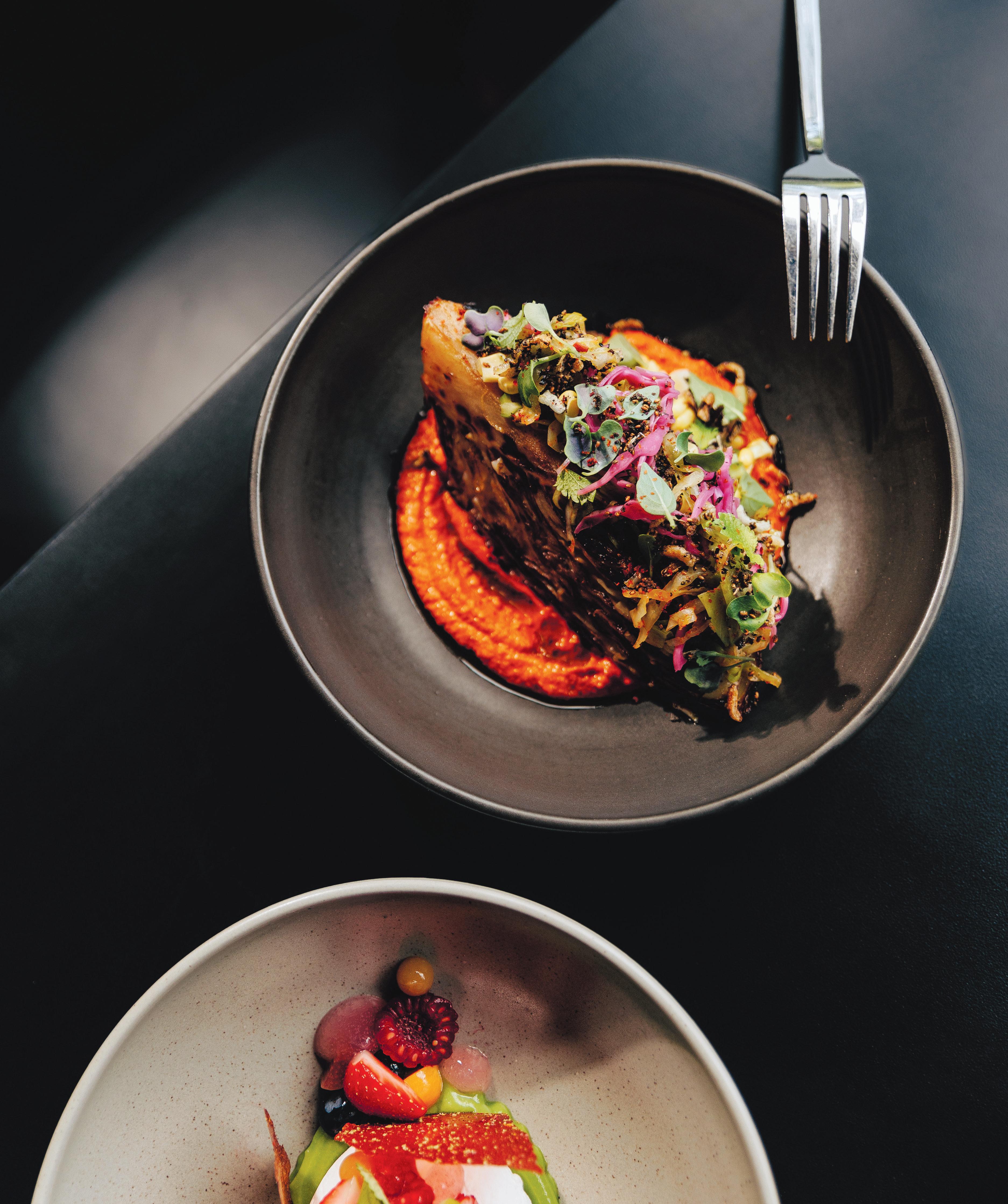
Ingredients
2 tbsp sunflower oil
2 tbsp miso
1 tbsp maple syrup
1 tsp apple cider vinegar
1 small green cabbage, cut into wedges
1 cup vegetable broth
Preparation
Preheat oven to 425 °F.
In a mixing bowl, mix the sunflower oil, miso, maple syrup, and apple cider vinegar.
In a large, hot frying pan, add a drizzle of the oil of your choice, then sear the cabbage wedges on each side on high heat until golden brown.
Remove the cabbage wedges and arrange on a baking dish. Coat the cabbage wedges with the miso glaze.
Add the hot vegetable broth so that it covers the bottom of the baking dish.
Cover with aluminum foil and roast for 45 minutes until the cabbage is tender.
Roasted tomato, pepper, and fennel emulsion
Ingredients
8 large red tomatoes, quartered with stems removed
3 medium red bell peppers, roughly diced
2 fennel bulbs, sliced
1 Spanish onion, sliced
3 garlic cloves, sliced
6 tbsp sunflower oil
2 tbsp maple syrup
3 tbsp apple cider vinegar
½ tsp gorria chili powder or Espelette pepper
Salt and pepper
Preparation
Preheat oven to 450 °F.
Place the vegetables and garlic on a baking sheet lined with parchment paper.
Drizzle with 3 tbsp sunflower oil and season.
Roast the vegetables for about 20 minutes, flipping them over halfway through cooking, until they begin to brown. Transfer the vegetables to a blender, add the remaining ingredients, and puree until the mixture is smooth.
Assembly
Spread the desired amount of roasted tomato, pepper, and fennel emulsion on the bottom of a plate. Place a hot cabbage wedge in the centre of the emulsion. Garnish with seasonal vegetables, if desired, and greens (arugula, lamb’s lettuce, or sprouts).
By Stéphanie Dupuy, sommelière
There’s something so satisfying about taking your time. To cook, to read a book, to wander through the forest… to live in the present moment. In a life that we often lead in fast forward, these moments in which we let our expectations and apprehensions fall away are often the most delicious.
For its part, wine doesn’t live its life in fast forward. If it only knows how to do one thing, it’s taking its time. We sometimes even say of a wine that we want to let age that we’re going to… wait for it! But what happens while we wait? How can a bottled wine improve over the years? And what conditions are necessary to allow it to reach its full potential? Here’s a brief guide to the basics of wine aging.
Like you and I, wine needs oxygen to live (and therefore, to age). Under its aluminum collar, the cork stopper lets in oxygen. The amount is minimal, but sufficient to allow the wine to evolve through complex chemical reactions. These reactions will have the effect of altering the wine’s appearance, taste, and texture over time. Red wines will change colour, becoming orange, then brown, while whites will become darker, first golden, then orange and brown. The primary aromas of youth (fruits, flowers) will make way for aromas of evolution, such as cooked and dried fruits, and other aromas such as humus, mushrooms, spices, grilling, and leather will appear. Finally, the tannins will soften, going from harsh to silky, giving the wine a more enveloping texture.

Photo: © Lia Bekyan
These changes will give the wine complexity, depth, persistence, and character… until it reaches its peak, deteriorates, becomes thin and flavourless, and finally dies. The ultimate goal when aging wine is therefore to catch it at the peak of its shape rather than at the end of its life. But how do you know if it’s the right time to open a bottle that you’ve been keeping for a few years? I may disappoint some people here: you can never be completely certain. There’s no miracle recipe, but there are a few keys to increase your chances of success.
First, you need to know how to buy properly. If the intention is to age a bottle, find out about the producer, the grape variety(-ies), the region, the vintage, etc. To draw broad generalizations, let’s say that red wines based on varieties that are richer in tannins (Cabernet Sauvignon, Sangiovese, Nebbiolo, etc.) have better storage potential, as do white wines with high acidity (Riesling, Chenin Blanc). The sugar content is also a good indicator. Dessert wines are among those that keep best.
Then, know how to store your bottles properly. The back of a closet is no longer sufficient for such a project! You should look for a dark place without any vibrations where the temperature remains stable (between 10 °C and 14 °C) and the humidity level is around 70%.
The last key is to track the progress for yourself. By having three bottles of the same wine on hand, you can taste it at different stages of its development. For example, you can try the first bottle after five years, the second after 10 years, and the last one after 15 years. This may seem like a rich man’s game, but it’s possible to find good storage candidates between $25 and $50. In any case, one thing is certain: you will have to be patient and let time take its course.
1. Juvé y Camps, Penedès, Casa Vella d’Espiells 2019, organic
13351459 — $25.50
Part of the aging work has already been done with this 2019 vintage. This Spanish Cabernet Sauvignon has a great intensity and is reminiscent of ripe blackberries, spices, and toasted nuts, with a very nuanced woody side. Although it’s a treat even if consumed immediately with lamb chops or your favourite piece of red meat, it will continue to improve for the next five years at least!

2. Anselmo Mendes, Vinho Verde, Muros Antigos 2023
12455088 — $16.65
If you have preconceived ideas about Vinho Verde (i.e., that this appellation produces very light and sweet wines), this 100% Alvarinho will make you lose them in an instant. Produced by Anselmo Mendes, a master of the vinification of this variety, you will find substance and freshness here. With aromas of stone fruits, apple, and citrus, you can enjoy it as an aperitif or with fresh Mediterranean cuisine. To be consumed within the next three years.

3. Domaine Cauhapé, Jurançon, Symphonie de Novembre 2021
10782510 — $43.00
The Jurançon region in southwestern France is known for its dessert wines. Here is one made solely from the Petit Manseng grape variety harvested late in the season—in November, as indicated by the name of the vintage. Very aromatic, citrus, pineapple, dried fruit, and a spicy and grilled aspect can be found here, all enhanced by a nice acidity that balances everything. To be enjoyed with a cheese plate or a tarte Tatin without delay… or in 15 years!
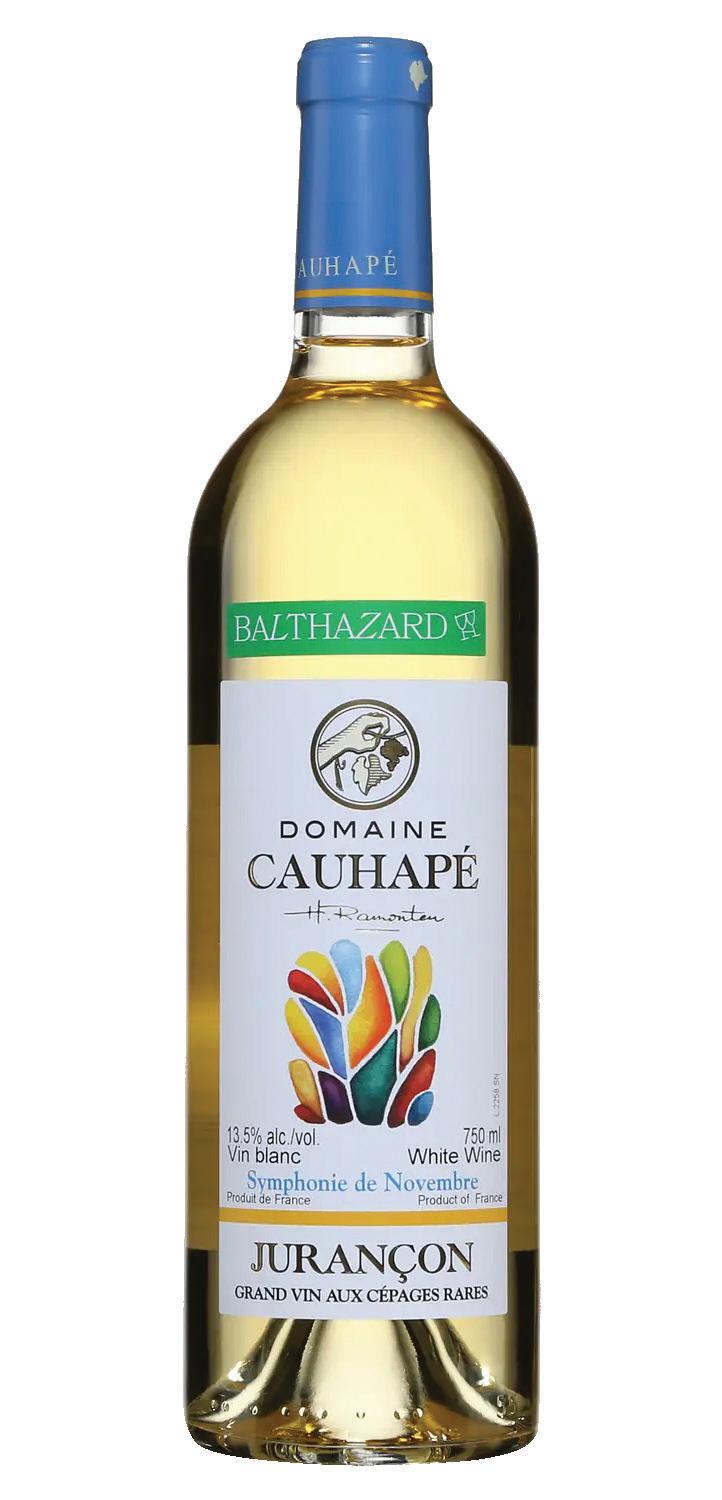
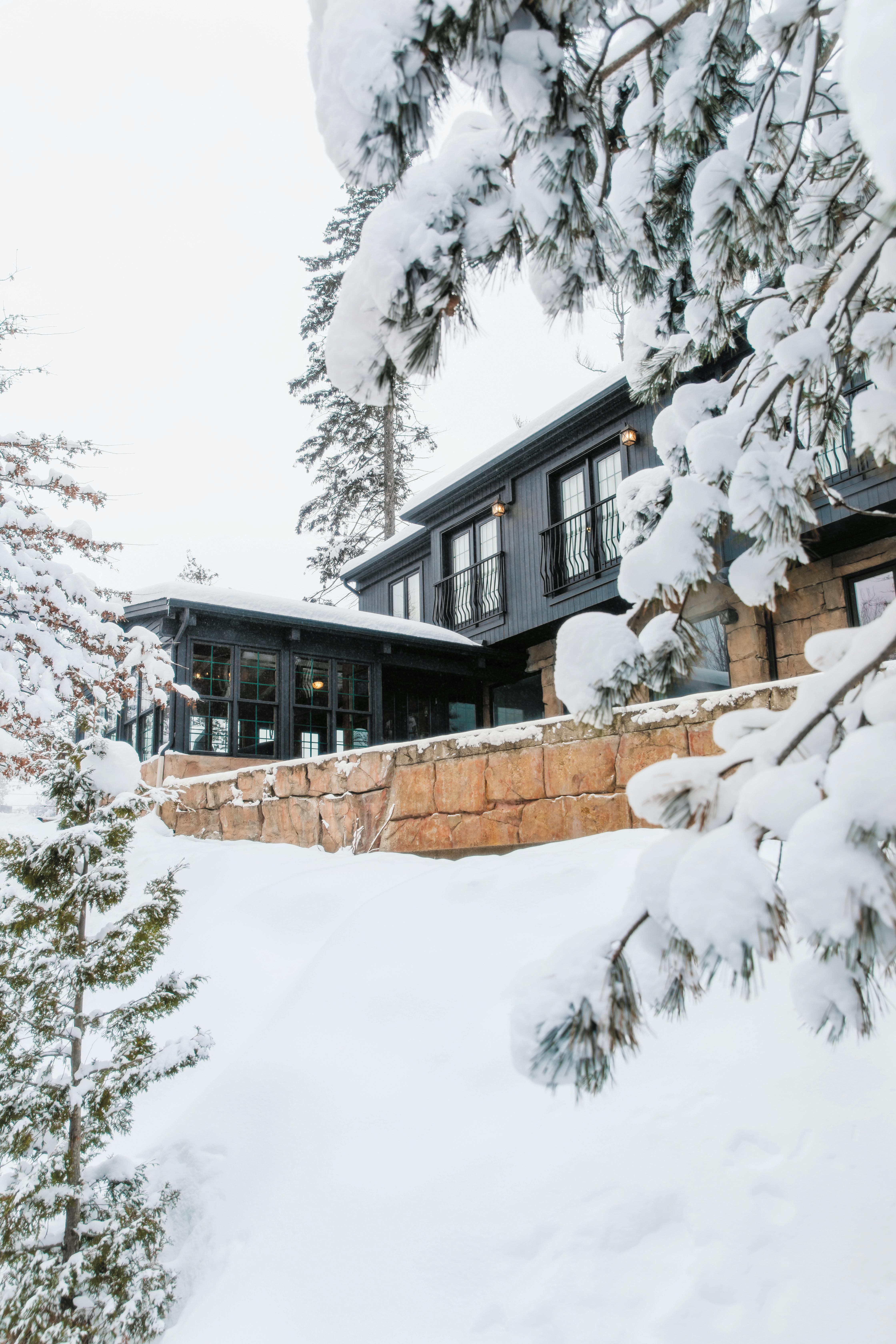
While nature slumbers, intimacy rubs shoulders with immensity, comfort embraces wonder, and the heat battles the cold at all five Strøm spas.
Come and take refuge at our facilities designed for wellness and enjoy the regenerating silence of the cold season which, when disturbed by the crackling of the fire, will make you wish that winter never had to end.

2. Winter appears like a painting in the background as you become one with the heat in the Finnish sauna.



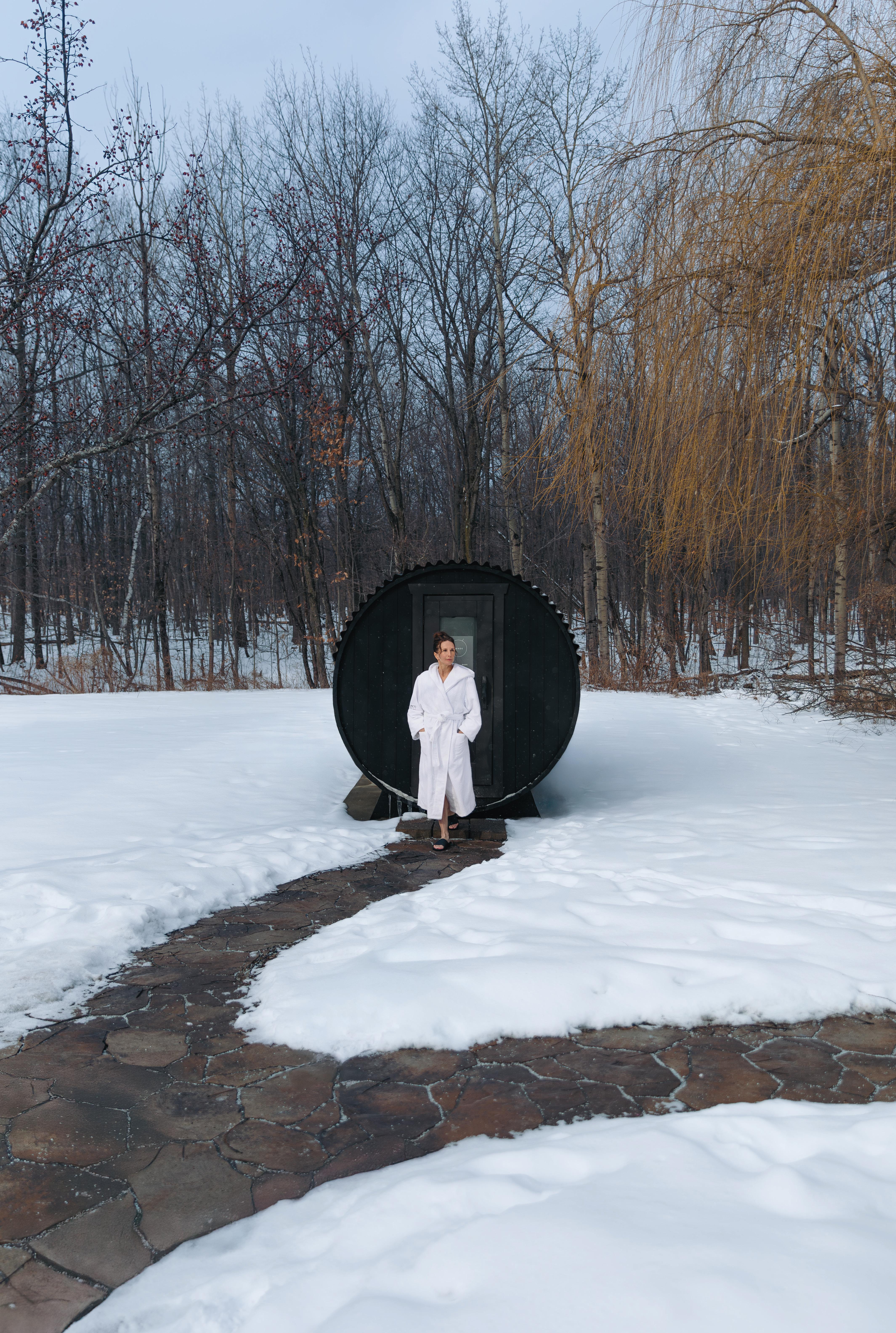

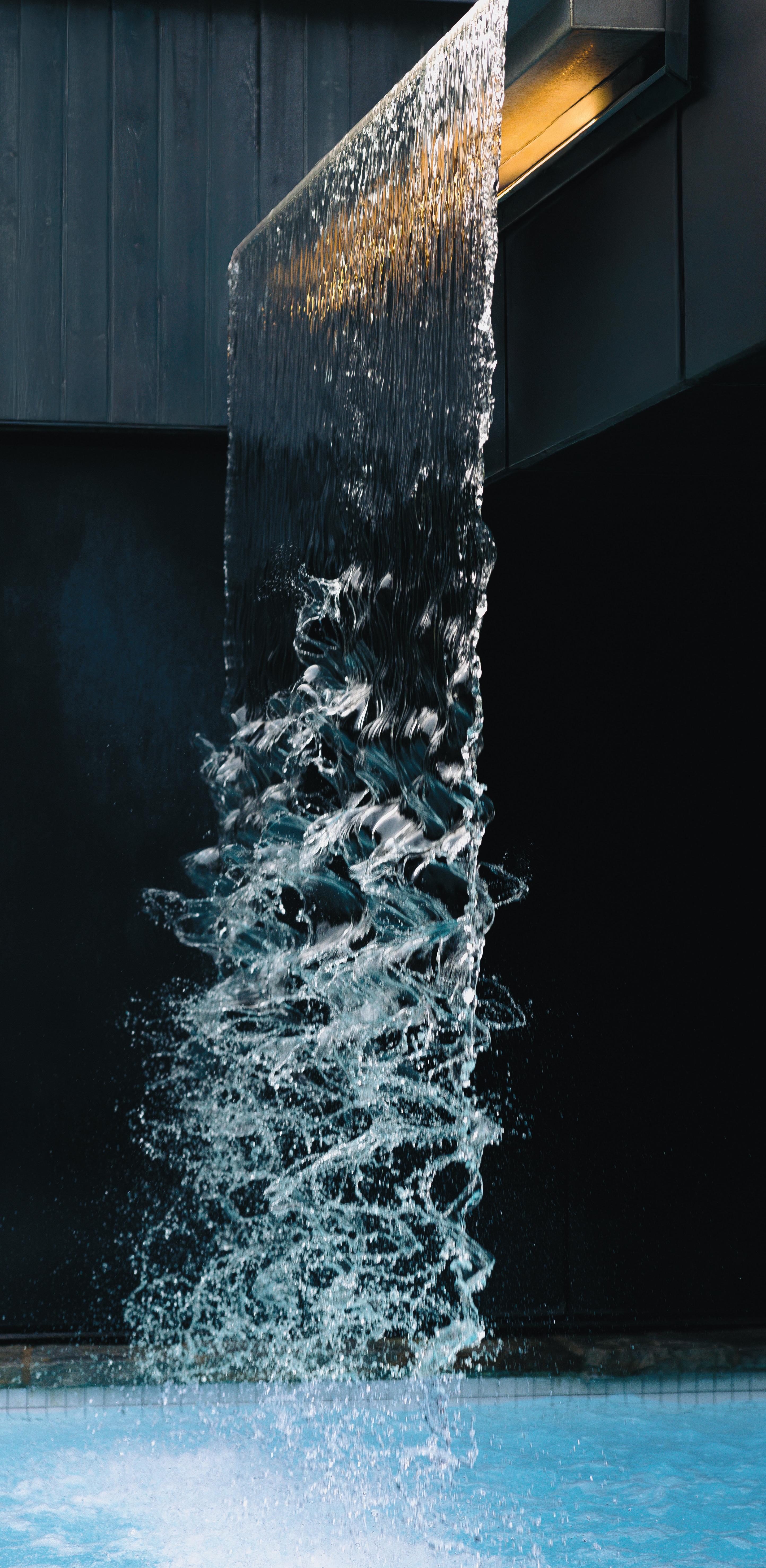
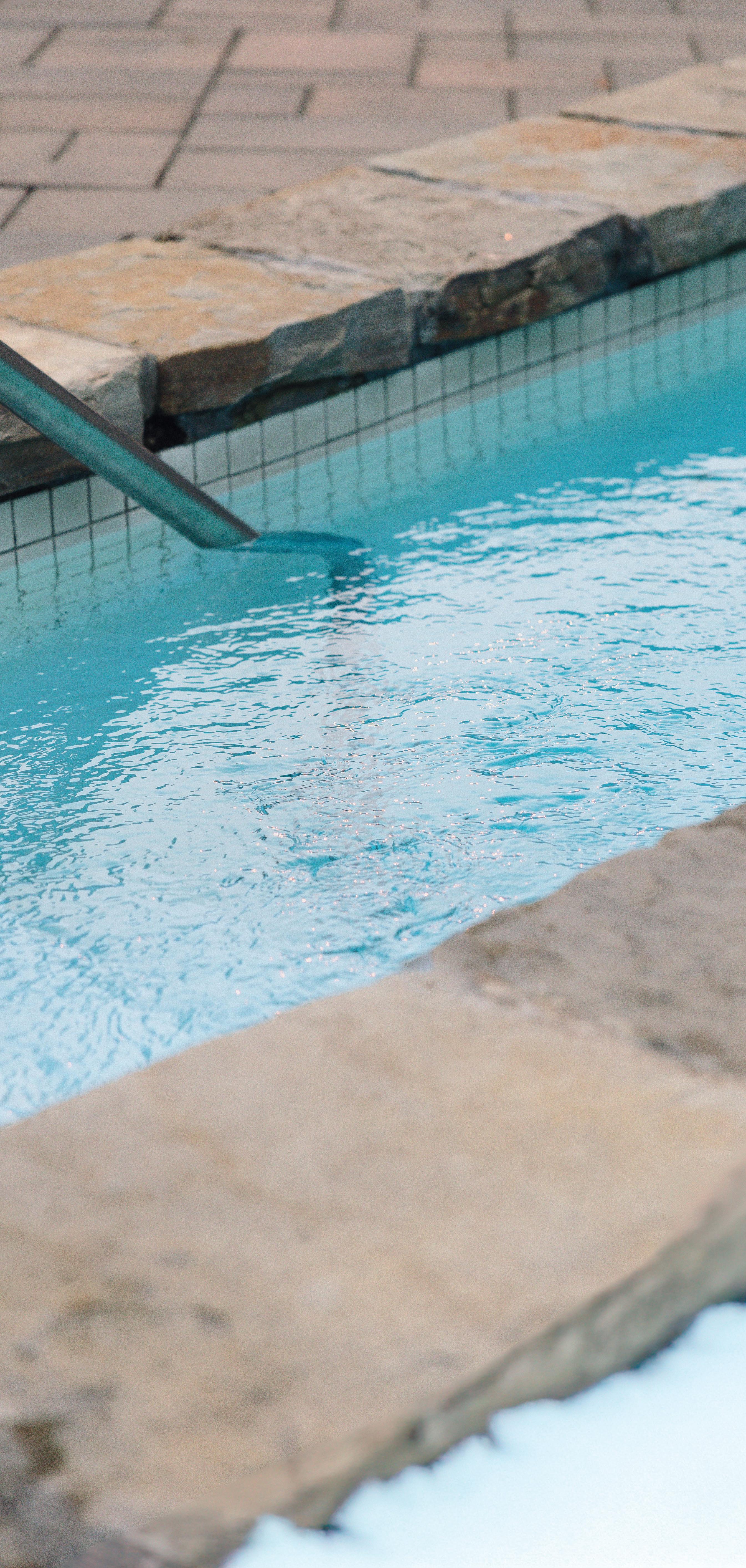




3. The architecture blends in with the territory, and the colour of the building recalls that of the surrounding conifers.

PROUD DESIGNER OF STRØM NORDIC SPAS
For more than 40 years, LemayMichaud has created worlds where architecture and design coexist and interact. From the exterior to the interior, everything is designed to create, build, and provide unique and perfectly integrated human experiences.
Quebec City + Montreal + Ottawa info@lemaymichaud.com lemaymichaud.com

FEEL THE COMFORT, EXPERIENCE THE ELEGANCE
Making you shine is our specialty. Combining comfort and femininity, each garment is designed and manufactured locally in Quebec City. Take advantage of Marilou’s style expertise in store or online.
15% discount with code STROM15 732, avenue Godin, Quebec City, Quebec G1M 1B5 mariloudesign.com

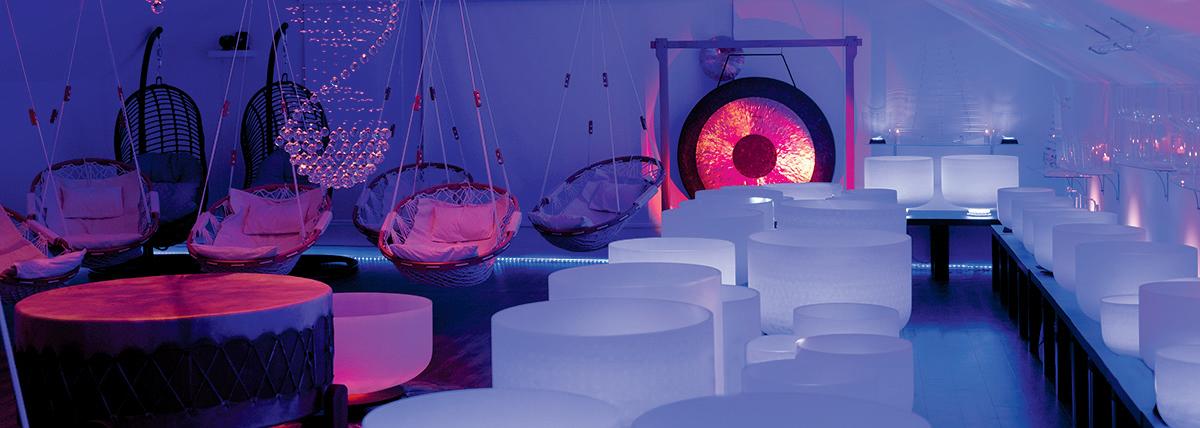
EXPERIENCE SERENITY WITH CRISTAL MOMENTUM
Concerts and immersive retreats:
Free your mind and let yourself be lulled by the harmonious vibrations of our concerts. Awaken your senses and immerse yourself in a relaxing sonic journey in the heart of Saint-Sauveur.
Public – Private – Corporate (450) 275-5520 Saint-Sauveur, Quebec cristalmomentum.com

THE PROMENADE WELLINGTON: A UNIQUE DESTINATION
10 MINUTES FROM NUNS’ ISLAND
The Well is more than just a street; it’s a dynamic neighbourhood that takes you on a journey thanks to its proximity to the riverbanks and its diverse range of shops, restaurants, and cafes.
(514) 766-6437
Métro De l’Église (Montreal) promenadewellington.com


LE PETIT CHAMPLAIN: A PICTURESQUE DISTRICT WITH A LOCAL FLAVOUR IN QUEBEC CITY
In a warm and magical atmosphere, come and meet welcoming merchants and artisans, creative designers, and passionate restaurateurs.
info@quartierpetitchamplain.com (418) 692-2613
61, rue du Petit-Champlain, Quebec City, Quebec G1K 4H5 quartierpetitchamplain.com


Vie en montagne is a renowned magazine established in Quebec offering unique content that delights both Quebecers and tourists. It explores friendship, creativity, authenticity, discovery, and positive environmental initiatives. Through remarkable photography, Vie en montagne highlights the characters, adventures, and challenges of the outdoors in
Quebec, inspiring everyone to create their own stories. The magazine is distributed in more than 300 locations, including hotels, shops, and professional offices, with special attention paid to the Eastern Townships, the Laurentians, and Quebec City.

How about inviting well-being to the workplace?

Let's work together for healthy workplaces.


